Bringing a Pet to China: An Expat Guide
Bringing a pet to China is not easy! Because of the health risk, China only allows pets to enter its borders according to the following strict regulations.
Only one dog or cat per person is allowed; no other animals. If the animal type or number is outside of regulations, for example, if you bring a hamster or two cats or dogs, your pet will be deported or destroyed. If you want to bring more than one cat/dog , assign a fellow traveler to accompany each of them.
If not accompanied, pets require an Import Permit to travel as cargo.
[Our information is largely translated from the official website of The General Administration of Customs of the People's Republic of China (www.customs.gov.cn), including
- General guidance on the import of pets
- New regulations on rabies test exemption brought into effect on May 1st, 2019
- Animal and Plant Health Inspection Service
We've covered the three things to prepare, where to enter China, what happens on arrival, quarantine (hopefully avoidable), and even bringing pets out of China.

Content Preview
- Prep. 1)Vaccination: Rabies Mandatory
Prep. 2) RFID Chips
Prep. 3) pre-entry health certificate, where to enter china, before entering china, on arrival in china, once in china: register your dog, bringing pets out of china, prep. 1) vaccination: rabies mandatory.
Each pet must have a rabies accinationcertificate showing the vaccination dates of two doses (the second dose must be between 30 days to 1 year before arrival), with manufacturer, period of efficacy, and batch for each. Unvaccinated working dogs may be vaccinated in China. See Quarantine below.
Other recommended vaccinations are canine distemper, parvovirus, and coronavirus for dogs; feline distemper, peritonitis, and feline leucopenia for cats; as well as kennel cough at least 2 weeks prior to import if quarantine is likely.
To avoid a 30-day quarantine, and to validate all other certification, making this an essential requirement , your pet must have a microchip implant. Basically, if China can't tell by RFID that your documents are for your pet, he/she will be deported/destroyed.
Animals entering China must be implanted with a microchip conforming to ISO11784 and ISO11785 for the radio frequency identification (RFID) of animals, i.e. with a 15-digit code. Other chips must have their own scanner. If you have a non-standard chip, you'd better be sure it can be scanned by a scanner provided by yourself!
You may want to get your pet chipped at the same time as the third preparation…
The pre-travel animal health examination is very important . If not done satisfactorily the cat or dog will be sent back to the country of origin or destroyed. If your cat/dog doesn't pass the health check, don't bring him/her until he/she does.
The health examination certificate must include: date of examination (must be within 14 days of arrival in China), type of animal, taxonomy, gender, fur color, birth date or age, RFID chip location, chip code, and date implanted, and health examination results (U.S. examples: certificate for dogs , certificate for cats ). It must be stamped by the accepted authority for the country, e.g. USDA for the U.S. or CFIA for Canada.
Pre-Entry Rabies Test
A rabies antibody titer test certificate may be required as part of the pre-travel health check. It must include RFID chip number, rabies antibody test time, test establishment name, and antibody titer results (at least 0.5 IU/mL).
From May 1, 2019, animals from 19 countries or regions can enter China without a rabies test: New Zealand, Australia, Fiji, French Polynesia, U.S. Hawaii, U.S. Guam, Jamaica, Iceland, UK, Ireland, Liechtenstein, Cyprus, Portugal, Sweden Switzerland, Japan, Singapore, China Hong Kong, and China Macau.
Rabies antibody titer test results are valid for one year from the date the blood was drawn, and should be after the second rabies shot. If your rabies test report is invalid, a new test must be performed at the port designated facility on-site and a new rabies test report must be obtained.
If you think quarantine is at all likely , you should use one of the ports of entry with quarantine facilities, probably in Beijing, Shanghai, or Guangzhou (see Quarantine below), otherwise, if quarantine were needed it couldn't be done, and your pet would be sent back or destroyed.
Beijing vs Shanghai : Which is Better to Visit? (City Comparisons) >>>
If you're certain your pet won't need quarantine, for example if you have a quarantine-exempt guide dog with a chip and all paperwork in order and who is healthy and ideally has been through the process before, only then should you consider using a non-quarantine port of entry.
If you plan to transit to a China city in another province after your arrival city, you should check inter-province animal transport certificate requirements with the relevant area's health and hygiene department and make sure you fulfil those too.
Fill in a ' Carrier's Immigration Pet (Dog, Cat) Information Registration Form ' (the bilingual 携带入境宠物(犬、猫)信息登记表.doc download from the China Customs page ). Choose which of the two form versions to fill in based on which country you're coming from with your pet: designated or non-designated. These will also be available at the port, but you might as well fill it in in advance to make sure you have all the necessary info to hand.
On arrival, the port authority will check the RFID chip corresponds with the certification you provide. If the vaccination and health check certification are ok, your pet can stay in China. Phew! First phase over.
If not, i.e. if you could not provide sufficient certification or exceed the type/number limits, customs should inform the port Animal and Plant Quarantine Office to take temporary custody of your pet(s). Then you would be consulted regarding pet repatriation. If that cannot be arranged, then sadly animal euthanization would follow.
If acceptable, an on-site health check follows…
Port On-Site Animal Health Check
If your pet passes the health check, the dog/cat can enter China accompanied by the carrier. Animals not from the 19 "no-rabies" countries mentioned above under Vaccination, must have an additional rabies check as part of the port health check.
Please allow enough time for animal checks and procedures at airports to avoid inconvenience/problems in keeping to your travel schedule.
If your pet does not pass the port health check, quarantine will follow…
Animals who don't pass the port health exam require 30-day quarantine. For example, to avoid quarantine, from May 1st, 2019, animals from the U.S.(apart from Guam and Hawaii), must have had two rabies shots, a chip implant, and a positive rabies titer (the antibody titer or the level of immune antibodies must be above 0.5 IU/ml).
Guide dogs, hearing dogs, and search and rescue dogs with the required health examination, RFID chip, training certificate, and satisfactory port health test report can enter China without quarantine. Such dogs with no acceptable vaccination certificate can, following application by the carrier, be vaccinated for rabies at a suitable establishment.
Emotional support dogs that are not guide dogs, hearing dogs, or search and rescue dogs, do not qualify for quarantine exemption if vaccination certification is lacking.
Where Quarantine Is Available
Pets that don't fit the qualifying criteria above must enter through and quarantine for 30 days in one of 10 designated ports:
- Beijing Capital Airport, Beijing West Railway Station
- Shanghai Pudong International Airport, Shanghai Honqqiao International Airport, Shanghai Port International Cruise Terminal, Wusongkou International Cruise Terminal, Shanghai Railway Station (on the HK Z-train)
- Guangzhou Baiyun International Airport
- Urumqi Diwopu International Airport, or Alashankou
Animals not meeting the above criteria entering through non-designated ports will be sent back to the country of origin or destroyed.
How Quarantine Works
For the period of quarantine, animals must not leave the quarantine area, and the owner shall be responsible for the animal's welfare or entrust the animal to the port quarantine office. Quarantine, welfare, management, and other expenses shall be paid by the owner to the animal and plant quarantine agency. For more details, please visit the The General Administration of Quality Supervision, Inspection and Quarantine of the People's Republic of China website .
If your pet exhibits abnormal health symptoms the quarantine staff will notify the carrier, and will, with the carrier's permission, treat the animal. If the animal can't be treated in the quarantine area, it will be moved and undergo treatment under customs staff supervision.
If you don't claim your pet within the stipulated time, he/she will be considered unclaimed and will be processed with quarantine treatment by the port Animal and Plant Quarantine Office.
Dogs must be registered with the police local to your place of residence within one month of arrival. Contact your local police office for how to do it.
You will need to register where you live first. See Renting an Apartment in China: An Expat Guide.
Carriers bringing pets out of China should prepare the following three things and show them at their port of departure at least a week before departure:
- 1. Valid rabies vaccination certificate (for vaccination from 30 days to 1 year before departure)
- 2. Carrier's travel document (passport or HK/Macau/Taiwan travel permit)
- 3. In advance, find out the destination country's animal health inspection requirements and prepare the required documentation in a timely manner.
After the animal carrier has submitted the required documents at the port of exit, the port will carry out an on-site animal inspection and provide an ' Animal Hygiene Certificate ', which the carrier must use to allow the animal to exit China.
According to the international practice of quarantine, the departure country vet should carry out quarantine procedures in accordance with entry country requirements (try to find these out and inform the port animal inspection team).
China Highlights Is Here to Help
Are you having trouble with China travel? You may want to seek help from a company who have been serving foreigners/expats traveling in China for over two decades. Contact us .
Want to discover more of China's highlights? See our tours designed for expats .
You Might Like to Read
- China Customs Requirements: What Can I Bring In/Out if China?
- How to Deal with Culture Shock in China More Easily
- The Top 10 Careers for Foreigners in China (Expat Jobs)
- A Traveler's Guide to Chinese Law
- 2-Week Private China Tour: Beijing–Xi'an–Lhasa-Shanghai
- 12-Day China Silk Road Tour from Xi'an to Kashgar
- 11-Day China Classic Tour
- 14-Day China Natural Wonders Discovery
- 15 Best Places to Visit in China (2024)
- Best (& Worst) Times to Visit China, Travel Tips (2024/2025)
- How to Plan a 10-Day Itinerary in China (Best 5 Options)
- 8 Days in China: Top 15 Tours and Itineraries (2024/2025)
- China Weather in January 2024: Enjoy Less-Crowded Traveling
- China Weather in February 2024: Places to Go, Costs, and Crowds
- China Weather in March 2024: Destinations, Crowds, and Costs
- China Weather in April 2024: Where to Go (Smart Pre-Season Pick)
- China Weather in May 2024: Where to Go, Crowds, and Costs
- China Weather in June 2024: How to Benefit from the Rainy Season
- China Weather in July 2024: How to Avoid Heat and Crowds
- China Weather in August 2024: Weather Tips & Where to Go
- China Weather in September 2024: Weather Tips & Where to Go
- China Weather in October 2024: Where to Go, Crowds, and Costs
- China Weather in November 2024: Places to Go & Crowds
- China Weather in December 2024: Places to Go and Crowds
Get Inspired with Some Popular Itineraries
More travel ideas and inspiration, sign up to our newsletter.
Be the first to receive exciting updates, exclusive promotions, and valuable travel tips from our team of experts.
Why China Highlights
Where can we take you today.
- Southeast Asia
- Japan, South Korea
- India, Nepal, Bhutan, and Sri lanka
- Central Asia
- Middle East
- African Safari
- Travel Agents
- Loyalty & Referral Program
- Privacy Policy
Address: Building 6, Chuangyi Business Park, 70 Qilidian Road, Guilin, Guangxi, 541004, China
- Skip to content
- Skip to main navigation
- Skip to search
- Skip to footer
- 台灣- English English 繁體中文 繁體中文
- 中国- Chinese English English 前往中華航空大陸站 简体中文
- 香港- HongKong English English 前往中華航空香港站 繁體中文
- 日本- Japanese English English 日本語 日本語
- 한국- English English 한국어 한국어
- Singapore- English English 繁體中文 繁體中文
- ราชอาณาจักรไทย- Thai ไทย English English
- မြန်မာ- English English
- Việt Nam- English English Vietnam Tiếng Việt
- Philippines- Philippines English
- កម្ពុជា។- English English
- Malaysia - English English 繁體中文 繁體中文 Bahasa Malaysia Bahasa Malaysia
- Bahasa Indonesia- English English Indonesia Bahasa Indonesia
- Deutschland- English English Deutsch Deutsch
- Nederland- English English Nederlands Nederlands
- Italia- English English Italiano Italiano
- Austria- Austria English English Austria German Deutsch
- Czech Republic- Czech Republic English English Czech Republic German Deutsch
- United Kingdom- English English 繁體中文 繁體中文
- United States- English English 繁體中文 繁體中文
- Canada- English English 繁體中文 繁體中文
- Australia- English English 繁體中文 繁體中文
- New Zealand- English English 繁體中文 繁體中文
- Explore the site menu

- {{((memberObj.mmname.length > 0)?memberObj.mmname:showName)}} Log Out Manage My Account
Frequently Used Functions
- Mileage Overview
- Update Personal Profile
- Upgrade Awards
- Award Tickets
- Award Transfer
- Mileage Correction
Dynasty Flyer Program
- How to Earn Miles
- How to Use Miles
- Skyteam Benefits
- Customer Service Hotline
- Membership Privileges & Obligations
Exclusive for Members
- Explore the Deals
- Birthday Special Discount
- Dynasty Flyer Welcome Offer
- Membership Tiers and Premium Benefits
- Member News
- Baggage Rules
- Free Baggage
- Special Baggage
- Excess Baggage
- Dangerous Goods Information
- Lost & Damaged Baggage
- {{classes.key2}}
Pet Transportation
- Before traveling with pets, travelers must contact our booking department to confirm transportation terms at least 48 hours before the flight departure time. Travelers must also download two copies of the same Passenger's Declaration for Live Animals (Baggage) , and submit one copy when checking in the pet at the check-in counter, and affix the other copy to the pet container. Pet transport services will not be accommodated without prior application.
- Transporting pets as baggage is a service that is only available for household cats, dogs (Including Psychiatric Assistance dogs for specific routes) and only available on flights directly operated by China Airlines and Mandarin Airlines, this service is not applicable if the passenger’s itinerary includes connection with interline segments.
- Pets must be placed in appropriate containers and transported in the cargo hold as checked baggage. Due to cargo hold temperature control considerations, we do not accept pets as checked baggage on our B738 aircrafts.
- Each flight can check in the maximum of 8 cages, and each passenger who occupies the seat (including children and infants who occupy the seat) can check in the maximum of 2 cages. Please also note that if arrival/transit countries have the restrictions such as the limited amount of pets can be carried, please mainly follow the regulations in such countries. Some countries have special regulations and require pets to be shipped as cargo.
- One pet per container.
- The different weight restrictions may be imposed on AVIH based on local airport authorities’ restrictions taking into account carrying facilities or capacity limitations at various airports. If the combined weight of your pet and the pet container exceeds the limits of departure/transit/destination restrictions. Due to the aforementioned factors, it may not be accommodated. Please be sure to contact our booking department in advance.
- Valid import/export document issued by the appropriate governments.
- Please have ready all of the import permits, health declarations and vaccination certificates required by all of the destination/transfer countries or regions on the itinerary.
- Other special documents required by any destination or transfer country/region on your itinerary.
- Passengers who intend to travel with live dogs into USA (including Hawaii and Guam) must follow the requirements and regulations announced by U.S. CDC (Centers of Disease Control and Prevention), please refer to the following website for more details. (Beginning July 14, 2021, there is a temporary suspension for dogs entering the USA from high-risk rabies countries. Please visit the following website for the full list of requirements and exemptions.
- We do not transport newborn (less than ten weeks old) dogs and cats
- Pets that have a strong odor can not be accepted either as checked baggage or cabin baggage.
- Pregnant pet has not been pregnant for more than 40 days.
- Pet may not be accepted for air travelling within 7 days after giving birth.
- In order for airport personnel to have ample time to make arrangements, please arrive at the airport 2 hours before your flight with your pet and check in.
Air Travel Pet Container Regulations
- The pet container must be of rigid plastic material as per IATA regulations, with only one door for the pet(s) to enter/exit, and can prevent the pet(s) from escaping or the claws from being exposed.
- The container must be able to allow the pet(s) to stand, lie down and turn in a natural manner. The pet(s) must be able to stand up without touching the roof.
- Types of Air Travel Pet Containers:
- Measurement Definition A = Length of your pet from tip of nose to base/root of tail. B = Height of your pet's fore limbs from the ground to the elbow. C = Width across your pet's shoulders. D = Height of pet in natural standing position from top of the head or the ear tip to the ground (whichever is higher).
- Pet Container Size Dimension Requirements Container length = A + 1/2(B). Container width = C x 2. Container height = D.

- As the checked pet normally will be loaded in the aircraft bulk cargo compartment during air transporting, the measurements on both height and width of the pet container will be limited as below: Max. external height of the pet container: 70CM Max. external width of the pet container: 90CM
Special Restrictions
- Pit Bull Terrier (including: American Pit Bull Terrier, American Pit Bull, Staffordshire Bull Terrier, American Staffordshire Terrier)
- American Bully
- Fila Brasileiro
- Japanese Tosa
- Dogo Argentino
- Mastiffs (Neapolitan Mastiff, Tibetan Mastiff, Bull Mastiff, Cane Corso, Dogue de Bordeaux)
- Affenpinscher
- Boston Terrier
- Brussels Griffin
- Bull Terrier
- Chinese Pug
- English Bulldogs
- English Toy Spaniel
- French Bulldogs
- Japanese Chin
- Japanese Pug
- Tibetan Spaniel
- British Shorthair
- Scottish Fold
- Transportation time (total travel time, including time on the ground during transfers) may not exceed six hours.
- Stations enroute within total transportation time under six hours that comply with standard transportation temperature restrictions are facilities that may handle the transportation of short-nosed dogs and cats as checked baggage. Other facilities may not handle the transportation of such pets as checked baggage.
- Allowed Regions: Taiwan, Northeast Asia, China/Hong Kong, not allowed in other regions.
- Allowed Months: January, February, March and December.
- The container must be one size larger than the regular size. All four sides of the container must have good ventilation.
- Start letting your pet stay in the pet container several days before your trip to get your pets accustomed to the container.
- No food may be placed in the container during transport. Water is allowed.
Service Dogs
Charge for pet transportation.
Before traveling with pets, passenger must contact our booking department to confirm relevant charge and terms of transportation at least 48 hours before the flight departure time. Transporting pets as checked baggage (AVIH), in addition to regular charge for pet transportation, if the total dimensions of each AVIH exceed 292cm(115in), 2 pieces of excess baggage charge rate should be applied and can be accepted as checked baggage subject to space availability of cargo cabin on the flight (The charges please check Excess Baggage )
- Passengers carrying pets as checked baggage should contact China Airlines in advance. Pets and pet containers may not be included in the free baggage allowance.
- Fees for transporting pets is determined by weight, including the weight of both the pet(s) and the container and following fixed rates are set for pets under 32KG.
- Weight > 32kg : Double fixed rate should be applied
- Fixed rates for pets under 32KG
- About China Airlines Go to CAL at a Glance page About Us Go to Careers page Careers Go to Media Center page Media Center Go to Investor page Investor Relations
- Services and support Go to Download Application Forms page Download Application Forms Go to Flight Messaging page Flight Messaging Go to Accessibility page Accessibility Plan and Feedback Process
- Related Websites Go to Sustainability page Sustainability
- Policies Go to Privacy Protection page Privacy Protection Go to Privacy Protection page Do not sell my personal information Go to Cookie Policy page Cookie Policy Go to Terms & Conditions page Terms & Conditions

Indicates external site which may or may not meet accessibility guidelines.

Bringing Pets To: China

Our clients are often surprised to learn that bringing a pet to China requires significant time and preparation. Our team of experts can provide an explanation of what this looks like, in addition to coordinating your pet's entire move, so you don't have to navigate it alone!
Need Our Support?
Let's Get Moving
What to Know Before Bringing Dogs and Cats to China
Microchip and vaccinations.
Make sure your pet meets these basic requirements so you can begin the import process.
Blood Tests and Other Treatments
The timeline for travel starts with your pet's first rabies vaccine, at least 30 days before travel.
Veterinary Credentials
Any veterinarian may administer the rabies vaccines, but the titer blood draw must be performed by a USDA accredited veterinarian.
Import Documentation
Once your pet's blood test is completed, the documentation process begins!
Quarantine and other information
If you follow our guidelines, your pet should not need quarantine in China.
China Pet Import Requirements and Timeline

Time frame: at least 30 days before departure date
Preparing your pet for transportation to China can be overwhelming, especially if your pet has health records in multiple locations and your veterinarian is not properly accredited. Ensuring that all required vaccinations are in line with import and export regulations is crucial. But don't worry; we are here to help!
Our experienced team will manage the entire process, including scheduling and coordinating the necessary 3-4 vet visits for vaccinations and blood tests. We provide sample documents to help ensure that everything is properly filled out and signed the first time, saving you time and avoiding potential delays.
We understand the importance of staying up-to-date on regulatory changes, and our relocation coordinators manage an average of 190 vet visits per month. Your pet's health and safety are our top priority, so all pets entering China must be microchipped and vaccinated. Keep reading below for more specific details and requirements.
How to start the process of moving your pet to China
- An ISO-15 Digit Microchip is required for entry into China.
Rabies Vaccination and Certificate
- All pets must have two rabies vaccines and original rabies certificates. These certificates must contain all vaccine information. The first rabies vaccine must be administered more than 30 days from the day of departure but within the last year. This vaccine must be an inactivated vaccine.
- Please note: the second rabies vaccine and certificate are now required to enter China without quarantine.
It is suggested that dogs and cats have the following vaccinations as well:
- Canine Distemper, Parvovirus, Hepatitis, and Leptospirosis
- Feline Cat Flu-Feline Calicivirus
- Feline Viral Rhinotracheitis
- Chlamydia Psittaci
- Cat Enteritis-Feline Panleukopaenia/Feline Parvo Virus

Making sure testing and treatments are done on time
To avoid quarantine, your pet will need two rabies vaccines and a passing titer blood test .
Make sure strict timelines are met
Rabies Titer (Rabies Antibody) Test
- Your pet will need a valid rabies vaccine and is under one year old at travel time. Once that vaccine is 30 days old, your pet can get their second rabies vaccine.
- After the second rabies vaccination, your pet can receive a rabies antibody test by an accredited veterinarian to ensure that the vaccination has provided adequate rabies antibody levels. The sample must be tested at a facility approved by the Government of China. Your vet will need to scan your pet’s microchip prior to the blood draw for the rabies antibody test.
- The date the blood was drawn can be any date after the second rabies vaccination is administered.
- The rabies vaccine must be valid and under one year old at the time of travel, and the second vaccine must be administered at least 30 days after the first. The date the blood was drawn for the rabies titer test can be any date after the second rabies vaccination is administered, but it's recommended to plan and schedule the blood draw as soon as possible to ensure timely results.
- Once these results have been returned to either yourself or the vet, you can move forward with planning your pet’s travel to China. Please contact your Relocation Coordinator at this time for further instruction.

Time frame: at least 30 days after your pet's first rabies vaccine
Your veterinarian must issue two signed rabies vaccine certificates and submit a passing rabies titer test.
What happens if your veterinarian isn't accredited?
- We can recommend an accredited veterinarian in your area, or work with your current vet to obtain the necessary credentials for your pet's import to China.
- Our team provides detailed templates and answers any questions your veterinarian may have to ensure all necessary paperwork is completed correctly.
- If your veterinarian does not have the required credentials, we can guide them through becoming accredited to avoid delays in your pet's relocation.
- We understand the importance of timing and can coordinate a final vet visit with an accredited veterinarian specializing in international travel preparation to ensure a smooth transition for your pet.

Time frame:within 7 days of departure
Once you have your test results back, you must make an appointment with a USDA-accredited veterinarian within 7 days of your planned travel date.
Avoid paperwork headaches by hiring experienced pet movers
China requires specific documentation for importing pets from the US.
Here are the key requirements:
China-specific USDA Health Certificate:
- Your USDA-accredited veterinarian should fill out this certificate, which must be issued within 10 days of your pet's flight.
USDA Endorsements:
Your local USDA office must approve the following documents:
- Two rabies certificates
- Vaccination records
- Passing rabies antibody test
- Veterinary Health Certificate for Export of Dogs/Cats from the US to China
Don't worry about the details - your relocation coordinator can guide you through this process and ensure that all documents are properly completed and submitted on time before your pet transportation to China.
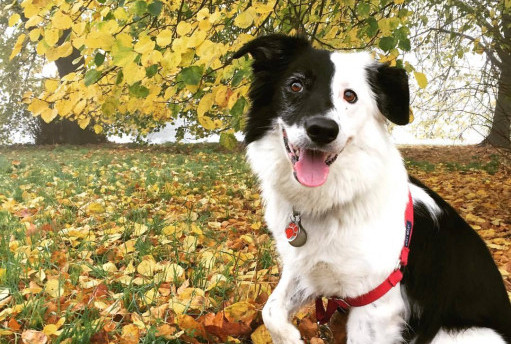
Your pet should be able to avoid quarantine in China.
If your pet does not meet the above requirements upon entry to China, you must complete 30 days of quarantine through an approved port.
Additional Information
- If your pet does not meet the above requirements upon entry to China, you must complete 30 days of quarantine through an approved port. We know this can be difficult to navigate, so we encourage you to contact our experts to learn how you can provide the most comfortable travel experience for your pet!
- Start the process early to ensure all necessary requirements are met and to allow for any unexpected delays.
Dog License
- Many major cities in China also require that dog owners obtain a dog license once the dog has arrived into the city. Beijing even requires this document prior to export, so if you’re planning on eventually leaving China with your dog it may be a good idea to look into obtaining a dog license upon arrival. This document can be obtained by visiting the local police station with your dog along with your passport, visa, and local address in hand.
One Pet Per Passport
- There is a strict one pet per passport rule that cannot be avoided if entering China directly. If you have more than one pet, your second pet's information must all be under of a friend or family member's name who is also moving to China.
Travel Stories and Tips

More Blog Posts from China

More Stories of Pet Moves to China
ChinaWhisper

7 Things To Know Before Traveling To China With Pets
New job, semester abroad, adventure. Any of those scenarios can be the reason you’re planning a trip to China . A new country means adapting to a new culture and all of its regulations that may differ from your home country. Whether your visit to China is temporary or permanent, you might be considering bringing along your beloved pet.
International travel for pets has certain risks that any responsible pet owner must prepare for and anticipate. What steps must be taken to ready yourself and your pet for long-distance travels?
If your travels to China will be for less than a month, hiring a friend or a pet sitter may be a better option than bringing your pet with you. However, if you are determined to have your furry companion cross oceans to be with you, there are a few things you should know about traveling to China with pets.

Credit: Photo by Alice Triquet on Unsplash
1. China Only Allows One Pet Imported Per Adult
China has very strict laws and regulations regarding the import of pets from other countries. Each foreign adult traveler is allowed to bring only one pet with them. Additionally, many areas in China only allow one dog per household. The dog must be registered to obtain a license. Cities such as Beijing have limits on a dog’s size.
While there isn’t a limit to how many cats one can own per household, cats must be vaccinated. All pets are required to have a booklet of immunization records. Culturally, China’s view of dogs as pets is complicated and may be vastly different from your home country.
2. There is a 30-Day Quarantine
Prior to 2019, all cats and dogs entering through airports into China required a 7-30 day quarantine until they were released into their owners’ custody. However, recent changes to regulation policies exempt pets from a mandatory quarantine if originating from designated countries must be microchipped and up-to-date on rabies vaccinations.
Pets being transported from non-designated countries are still subject to a quarantine. The owners must pay for the quarantine and are not allowed to visit their pets during the quarantine.
3. Some Breeds Are Banned in Certain Areas of China

Credit: Photo by Nathalie SPEHNER on Unsplash
As a country, China does not have bans on any dog breeds. However, Shanghai, Chengdu and Beijing have restrictions on breeds that are allowed to live within city limits. The restrictions are based on the size of the dog.
Weimaraners, St. Bernards and Great Danes are a few examples of the large dogs that fall under the restrictions. Furthermore, many places in China have one-pet-per-household laws.
4. Not All Airlines are Pet-Friendly
If you’re traveling to China, chances are high that your mode of transportation is an airplane. However, not every airline is pet-friendly, even if you’re flying domestically. When booking your flights , be sure to check the airline’s pet policy.
Many airlines also have restrictions on how many pets can fly per flight. If you know you’re flying with your pet, book as early as possible to secure one of the pet slots. In addition, flights with long layovers can be too much stress on pets.
5. Cargo Travel Can be Dangerous for Pets
Very few airlines allow large dog breeds to fly with their owners in the cabin. Instead, the dogs are placed in cages and transported in the cargo hold of the plane. Unfortunately, the cargo area is suitable for luggage, not animals.
Smaller pets are often allowed to travel in the cabin if they are secured in carriers that fit underneath the seats. Many airlines have strict measurement limits for the carrier. Find the best pet carrier for air travel to keep your pet safe and secure during travels.
6. Microchips, Vaccinations and Other Required Forms
Recent changes in the regulations for importing pets into China requires all pets to have a microchip. In addition, they must have a rabies vaccination that was given within 30 days to one year of the time of travel. Depending on the pet’s country of origin, a rabies titer test might also be required.
A health certification from your pet’s veterinarian is necessary for bringing your pet with you to China. You must also have permission from your country’s government to export your pet to another country.
7. There are Regulations for Bringing Your Pet Home

Credit: Photo by Dimitry Kooijmans on Unsplash
The entry requirements for traveling to China with pets are almost exactly the same upon heading home except for the quarantine. Your home country will likely have their own requirements for importing a pet.
Before you can take your pet home, you’ll need an official immunization and health certificate from a local animal hospital. Your pet will also need an exit permit from the Entry-Exit Inspection bureau. The owner has to present their passport, so be sure to leave AFTER your pet has secured passage.
Consider the Financial and Emotional Burden of Pet Travel
Traveling to another country with your pet is financial and emotional undertaking that needs to be seriously considered. If there’s no other option except to bring your pet along with you, such as job relocation, then you can expect to shell out a serious amount of money to travel with your pet companion.
Any pet owner will tell you that having their pet with them is priceless. However, your pet’s ability to handle stressful situations should also strongly factor into your decision. Not every pet has the tolerance for long-distance travel, no matter what the mode of transportation.
Leo Wilson graduated from a university major in animal health and behavior. He had over a decade of experience working in the pet industry and has contributed many dogs and pet-related articles to several websites before he decided to start sharing his knowledge on his own blog . And when he is not busy working, he and his wonderful wife love spending time at home with their 3 dogs and 2 cats.
Leave a Reply Cancel reply
Your email address will not be published. Required fields are marked *
Save my name, email, and website in this browser for the next time I comment.
- Top 10 Online English Shopping Websites From China
- Best VPN for China in 2022
- Best Chinese Dating Sites


How to Bring Your Pet to China | Expat Guide
In addition my friends' experiences, I’ve shipped my dog (a golden retriever!) from the U.S. to Asia. Hopefully by sharing my own experience, you can get a better understanding of what it takes to ship your pet to China, how much it can cost and what you need to know.
Requirements | Bring Your Pet to China
China, like most other countries, has a number of different requirements in order to import your dog or cat. These requirements include:
- Proof of Rabies Vaccination: Your pet should already have this vaccination, but you’ll need proof.
- Vet-Approved Health Certificate : We had to get a health certificate for our dog, and that had to be completed no more than a week prior to my dog’s flight.
- China Export Documentation: This documentation comes from your home country for importing your dog or cat to China.
- Mandatory Quarantine: Unfortunately, your pet will have to spend between 7-30 days in quarantine upon entering China (time dependent on the rabies status of the country from which the pet is imported).
Keep in mind that there are limits on how many pets you can bring. You can only bring one pet per one adult with a work visa, and in most cities like Beijing, you can only register one pet per address. For most animals, the import is considered commercial.
Note that bigger dogs (taller than 14 inches or 35 cm) and 41 specific breeds that are deemed violent are banned from Beijing’s city center. So your golden retriever may be too big to live within the fifth ring road. Bulldogs and other breeds are not allowed at all. Check here for a list of dog breeds that aren’t allowed in Beijing .
Dogs need to be registered in Beijing, as with many other major cities in China. You can register only one dog per household address, so you may need a friend’s address if you have more than one dog. Detailed information about registering your pet in Beijing can be found on the International Center for Veterinary Services in China .
This is China, so regulations seem to change often and even differ by point of entry, so best check with a company that specializes in international pet travel or relocation. In my case, I used a pet relocation service in Texas, U.S.A. (my home city) that helped with all the paperwork. It was more expensive, but it was so much easier.
Consider How to Get Your Pet Back Home
Truth be told, my Australian friend’s next headache will be to get their furry family member back home once his assignment in Beijing is completed. Australia doesn’t consider China a safe country for pets to come from. And for such “unapproved countries” special import requirements apply, including a long quarantine apply.
The important point to note here is that there are special regulations to consider for bringing your pets back home. Here are websites with more info with the following countries:
- Bringing a Pet Back to the U.S.
- Bringing a Pet Back to Australia
- Bringing a Pet Back from the U.K.
Bringing a pet back to Europe is easier. Most European countries require a blood titer test to confirm antibodies against rabies if your pet comes from a high rabies country like China. The test is performed in Switzerland, so a blood sample is sent around the world.
In most cases you’ll find that your pet needs a rabies vaccination, a checkup from a certified China veterinarian, a microchip (which needs to be implanted before the vaccination) and other paperwork. Adhering to the required timeline between vaccination, blood test and travel requires some advance planning, so start your research early to avoid quarantine.
The US requires rabies vaccination and for dogs proof of screwworm treatment when coming from China. Compared to Australia, very straightforward and easy.
So before you decide to bring your dog or cat to China, you need to find out how difficult it will be to bring you pet home, or on to your next assignment, after spending time in China. This will differ for all countries. Of course the same applies for a pet you adopt here.
How Much Does Pet Relocation Cost?
The cost of having your pet come with you to China will vary by type and size of animal, country of origin, use of a professional pet moving company etc.
For example, if you’re shipping a large breed dog to China from the United States using a pet relocation service, you can expect to pay as much as US$5,000. Smaller breeds are obviously cheaper as would be arranging all the shipping/paperwork yourself.
No matter what method or country, you should budget at least a couple thousand dollars to bring your pet to China.
If you are sent to China by your company they will usually pay for relocating your spouse, kids and household items. For pets however, you’ll typically have to pay yourself.
Consider the Costs for You and Your Pet
Given the cost and the stress for the animal and also the quarantine requirements, it only makes sense to bring your furry friend if you are staying in China for a longer period of time. It also matters whether your dog or cat is healthy. Get all the information about importing and exporting your pet before making the decision.
Some pets are skittish and would likely be traumatized by such an international trip. You also need to think about what it will be like to have a pet in China . For example, let’s say you want to get away for a little while to see other parts of Asia. Who is going to watch your pet while you’re gone ?
In some cases, it would be better to leave your dog with friends and family until you return.
I realize that your pet might be a part of your family, and the thought of leaving them behind is crazy. Consider their health, though, and make sure it’s a good idea both for your pocketbook as well as their well-being.
Final Thoughts | Pet Relocation to China
I’ve relocated my pet to Asia and it was worth it for the sake of my wife and kids. My dog survived the trip without any issue and we got through quarantine quickly. I won’t lie, though…it cost me a lot of money .
Hopefully my experience has given you a bit more information and maybe put your mind at ease. It’s possible but there’s definitely a lot of prep work that needs to be done to make it happen.
What is your experience with bringing your pet to China? Please share in the comments so other dog and cat lovers can learn from you!
Ruth moved to Beijing in 2011 with her husband and later started the Beijing Expat Guide. Although she has since left China, she still comes back often to visit friends and fill up on delicious Chinese food.
You Might Also Like
International schools in beijing, how to receive mail at a chinese address, is beijing safe, what to bring when moving to china, join our facebook community.

Tools and resources to navigate expat life in China.
- work with us
- Travel in China with Your Dog: Tips for Flying with Pets
- China Travel Blog

- in China Travel Tips
For many of us, travelling without a pet runs the risk of being nervous throughout the journey. We can’t just separate from our beloved companions, especially when travelling abroad. Our dogs are spoiled at home. But when it comes to taking an air travel in China, there are many restrictions and requirements you'll need to consider.
Here are some suggestions for taking your pet on a plane in China, making the journey easier and more safety for both you and the pet.

1. Consult with your airline. Make sure there is an aerobic cabin (the cargo hold exclusively for pets) available to transport your pet on the flight before booking the ticket. it's best to fly in the morning or evening during the summer, and midday during the winter to avoid extremely hot or cold temperatures.
2. Call the airport to get to know the restrictions for your pet boarding. it is suggested that you arrive at the airport three hours before the department time. Consider booking a direct flight to help ease stress and anxiety for your pet and avoid the wrong transporting.
3. Carry the health certificate of your pet issued by a vet. This is the first and foremost thing to keep in mind.
4. Prepare a pet travel carrier with drinking bowl. Consult with your airline about the size and the specifications.
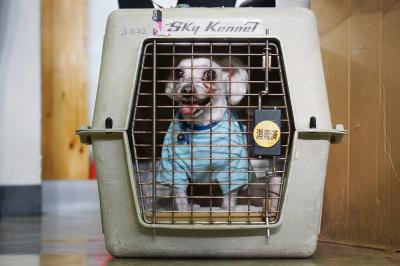
5. Affix a travel label to the carrier with your pet’s name and your contact information, in case that your pet gets strayed .
6. Consider giving your pet tranquilizer. Generally, sedation is not advised. But talk with your veterinarian whether or not to prescribe a tranquilizer for your pet prior to flying.
7. Feed the pet at least 3 hours before the flight. Pee before boarding to avoid stomach upset and discomfort caused by the high-altitude flight.
8. Upon Arrival: when arrive at the destination, wait for about 1 hour to get your pet on the local cargo terminal.
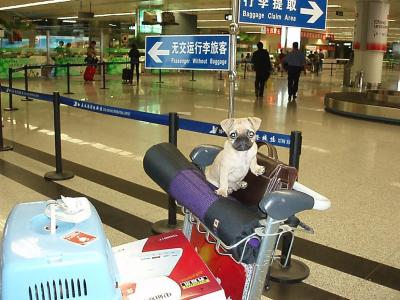
Familiarize yourself with the additional pet policies of different airlines in China
China Airlines (Taiwan) – Passengers with pet should contact with the reservation department in advance, and arrive at the airport two hours before the departure time. The disability assistance dogs, including guide dog, hearing dog are allowed to accompany the master on the plane without paying additional transportation fee.
Air China – This airline may refuse the pregnant pets, and those who have just given birth within 48 hours.
China Southern Airline – Each passenger can transport only one pet, weighing no more than 32kg. Each pet should be put into a separate cage or travel carrier. However, a pair of birds can be put in the same cage. Moreover, passengers travelling with pet should apply for the pet transportation at least 72 hours before flying. Make sure to arrive at the airport no less than 1.5 hours prior to the scheduled departure time.

Top-selling China tours by Easy Tour China:
8-day China Golden Triangle Tour
11-day Golden Triangle with Yangtze Cruise
15-day China Impression with Yangtze Cruise
- Google Plus
Leave a Comment

- Help Center
Travels With Fluffy: How to Take Your Pets In and Out of China
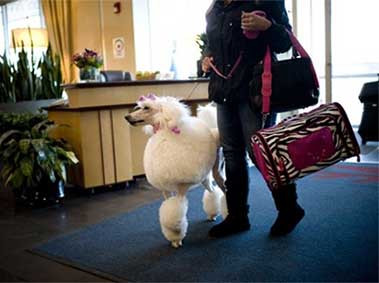
No one wants to leave their pets behind when relocating to a new country. But the paperwork and high fees involved make moving pets over borders a bureaucratic headache. To make the transition a little easier, we’ve compiled a guide to help you navigate China’s pet entry and exit requirements.
Know this Before You Start
Only one pet per passport is allowed to be brought into China. Once you’ve arrived, only one dog is allowed to be registered per household address. If you want to bring more than one pet into the country, someone else will have to bring additional pets on your behalf. You must also find someone without a dog to register it to their household, since multiple dogs aren’t allowed.
Cats are easy. Dogs are hard. Dogs must undergo regular vaccinations and yearly registrations. Nobody from the government really cares about your cats or other house pets after they’ve gone through quarantine. More on dog stuff later.
To bring any pet into China, however, you must have a residence visa. Students and tourists need not apply, because your pet won’t get past immigration.
While no specific breeds are banned in China as a whole, certain cities do have size and breed restrictions. In Beijing’s eight major districts, for instance, dogs must not be taller than 35 centimeters from ground to shoulder. You can find a list of banned breeds in those districts - which are roughly all located inside the 5th ring road - here .
Research your particular city’s regulations before spending time and money on transporting a dog that might end up confiscated by authorities.
Before Departure
Dogs must get rabies vaccination more than one month but not less than one year from your departure to China. Be sure to get the vaccination certificate from your vet. Note that China does not recognize two- and three-year vaccinations. Also, China does not require a blood titer test (RNATT) for pets entering from any country.
Other vaccines are suggested but not required, including canine distemper, parvovirus, hepatitis, leptospirosis, feline cat flu, feline calicivirus, reline viral rhinotracheitis, chlamydia psittaci, cat enteritis, feline panleukopaenia, and feline farvo virus.
Once you’re sure your pet has a clean bill of health, obtain its vaccination records (different than the rabies certificate) and vet health certificate from you veterinarian. In the US, the latter is called form 7001. If your pet is microchipped, get its microchip implantation record as well, although microchipping is not required to enter a pet into China.
Take all that paperwork and send it to your country’s national animal control bureau (the USDA in the United States, CFIA in Canada). Within 14 days of your departure, the bureau must give its stamp of approval or endorsement on a veterinary certificate.
After Arrival
China does not require an import permit for pets entering with their owners from any country. That means as long as you’re flying on the same aircraft as your pet, a permit is not required. But if you send your pet on a separate cargo plane, it will require the import permit. The permit should be obtained by someone acting on behalf of the owner or an agent in China.
Once you arrive at the airport, you must present your passport, and it must match the name on all the certificates mentioned above.
After your pet has been cleared, it must go into quarantine. You must pay a fee of 280 Yuan at the quarantine station. Quarantine policy varies city to city and depending from which country you’re coming from. In Beijing and Shanghai, for instance, the minimum quarantine is seven days for the UK, North Korea, Hong Kong, Greece, Singapore, and Germany. But pets coming from the USA, Canada, Italy, France, and Russia require a minimum 30-day quarantine for the same cities. You can find the full lists here .
Some cities have a designated quarantine facility, while others will allow you to quarantine your pet at your place of residence. In many cases where the quarantine period is 30 days, your pet will be kept at a facility for seven days and at your residence for the remaining 23 days.
If you quarantine your pet at home, expect an official to pop in on a random day to check up on the health of your pet. This can include a stool sample.
Once your pet is out of quarantine, you can pick up your vaccination verification at the quarantine facility and/or vaccination office. It’s a small red book. You’ll need it to register your pet.
Registration
The registration process varies city to city and precinct to precinct, so just to be safe, gather together all of the following:
• Your passport and housing registration certificate.
• Your dog’s vaccination certificate and verification
• Two color photos of your dog; passport-sized, from the front
• Some require you to bring the dog itself
• Lease contract for your apartment
• Permission from neighborhood watch committee, if you have one
• Money. Depending on the city, this varies. In Beijing, it costs 1,000 RMB for initial registration inside the 5th ring road, and 500 RMB for renewal
Take all this with you to your local precinct (the place that you obtained your housing registration certificate).
It can take up to one month to actually receive your pet registration card. Until you have it in hand, keep the fapiao with you any time you’re out with your pet to show your pooch is legit. Otherwise, police have the right to confiscate your pet.
Fun fact: some cities, including Beijing, offer a discount for owners that spay or neuter their pets. You must obtain a spay/neuter certificate from your local animal hospital (note: must be an actual animal hospital, not a clinic or pet shop) to prove Fido is no longer equipped.
All dog licenses collectively expire at the end of April every year. You must renew the registration before the beginning of June. Don’t forget to keep up with the rabies shots.
Leaving China
Remember that each airline has its own rules for transporting pets. Be sure to check the website of whichever one you’re flying with to stay updated on their policies.
Also, every country has its own policies and restrictions regarding pets, so be sure to educate yourself and don’t get Fluffy stranded at an airport. Ask these questions: is RNATT (Rabies Neutralising Antibody Titre Test) required? Is a microchip required? What are the quarantine regulations?
These guidelines apply to China only:
The exit procedure is a three-step process. First, you must immunize your dog against rabies in China. Again, cats and other house pets are much easier; they don’t require rabies vaccinations and the related paperwork. If you did it in your home country and the vaccination hasn’t expired, you must re-vaccinate your dog again on the mainland. Bring the vaccination certificate back to the vaccination office. They’ll give you a certificate of health, which the airport veterinarian will check before allowing your pet to leave. Just as with bringing your dog into China, the vaccination must take place less than one year but no longer than 30 days prior to departure. The red book you got earlier should include this information.
Next, you must take your pet to the local designated animal hospital (again, not a pet shop or private clinic) to get a health examination. Once that’s done and your pet is confirmed to be healthy, you’ll be issued a health certificate. This must be done within 14 days of your departure.
Lastly, your pet needs an exit certificate. This shows your animal is in good health and is ready to exit China. Take both of the documents from the previous two steps to the Exit-Entry Inspection and Quarantine Bureau, along with your passport. Your pet doesn’t have to accompany you. A small fee must be payed and varies depending on the city. Plan to do this about one week before you travel, as it can take a couple days but must be obtained no more than seven days prior to travel. It will be valid for two weeks in case your flight changes.
Sounds Complicated? Hire an Agency
As you can see, getting your pet documented, transported, and registered in China can be a complex process. But you don’t have to go it alone. There are a number of agencies that can assist in various aspects and will save you the headache. If you can afford it, this is the recommended way to go.
What to Expect from Your Employment Contract in China?
Sign up a free account and receive the free career advice from other expats.

To continue reading the full article, please sign up a free account
Looking for jobs in china, thousands of jobs updated daily.
Follow Us On: Facebook | Twitter | Instagram | Linkedin
Warning: The use of any news and articles published on eChinacities.com without written permission from eChinacities.com constitutes copyright infringement, and legal action can be taken.
Keywords: take pets to China bring pets from China
Related Articles
- You’ll Never Walk Alone: Owning Pets in China
- How to Raise a Pet in Beijing
- The Five Essential Stages to Buying a New Puppy in China
Create an Account (it's free) To receive career advice, articles and job alerts in China.
- Possible selections:
Welcome to eChinacities Tell us a little about yourself so we can customize your site experience
- Czech Republic
- Netherlands
- New Zealand
- North Korea
- Philippines
- South Africa
- South Korea
- Switzerland
- United Kingdom
- United States
- Afghanistan
- El Salvador
- Equatorial Guinea
- Liechtenstein
- Palestinian Territory
- Puerto Rico
- Saudi Arabia
- Sierra Leone
- Slovak Republic
- Turkmenistan
- Trinidad and Tobago
- United Arab Emirates
- Fuzhou(Jiangxi)
- International
- Lianyungang
- Other cities
- Pingdingshan
- Qinhuangdao
- Taizhou(Jiangsu)
- Taizhou(Zhejiang)
- Zhangjiajie
- Email Login
All comments are subject to moderation by eChinacities.com staff. Because we wish to encourage healthy and productive dialogue we ask that all comments remain polite, free of profanity or name calling, and relevant to the original post and subsequent discussion. Comments will not be deleted because of the viewpoints they express, only if the mode of expression itself is inappropriate.
Please login to add a comment. Click here to login immediately .
Guest769452 ( 2 ) ( 1 ) comment|--> -->
Wtf----- I ain't marrying my dog, pathetic..
Sep 07, 2015 14:23 Report Abuse
Karajorma ( 2 ) ( 1 ) comment|--> -->
Gonna keep on living in sin?
Sep 08, 2015 10:19 Report Abuse
Add your comment
- - Click to confirm or cancel the marker position.
- - Draw the marker to another location, and then click to confirm the new marker position.
- Scan the wechat QR code for:
- Online customer service
- Managing online ads any time
- Response from invited applicants
- Gifts and discounts

- PhoenixMiles
- Special Offers
- Information Inquiry
- Self-service
Pet Transportation
Pet transportation is limited to domestic dogs and cats. Cats and dogs that are aggressive and may injure people, as well as pure and mixed cat and dog breeds with short snouts that are prone to breathing problems, are not accepted for transport.
including but not limited to: Terriers (e.g. Schnauzer, Boston Terrier), Boxers, Bulldogs, and Spaniels, mastiffs, pugs, mastiffs, American Staffordshire terriers, American pit bull terriers, English cocker spaniels, English toy spaniels, King Charles spaniels, bullmastiffs, Affenpinschers, Lhasa apsos, Pekingese, Chow Chows, Japanese chins, shar-peis, shih tzus, pit bulls, Japanese mastiffs (including Tosa-Inus), Brazilian mastiffs, Dogo Argentinos, Burmese cats, Himalayan cats, Persian cats, exotic shorthair cats (such as 'Garfield'), etc.
Cats and dogs that are pregnant, less than 8 weeks old, nursing, have given birth within 7 days or are sick will not be accepted for carriage.
1. Eligible flights
Pet transportation service for Air China-coded point-to-point flights (including layovers) operated by Air China, as well as flights with domestic–domestic or domestic–international transits to connecting flights and transit times of at least 2.5 hours at Beijing Capital Airport, Shanghai Pudong Airport, or Chengdu Tianfu/Shuangliu Airport, can be booked via the Air China website or app. If your transit time is longer than 4 hours, you must claim your pet at the transit airport and take care of them yourself before checking them in for onward transport.
If the destination airport of the first flight segment is not the same as the departure airport of the subsequent flight segment, you must claim your pet at the destination airport of your first flight segment, take it to the departure airport of the second flight segment, and check your pet in for transportation again.
The pet transportation service for transit and connecting flights must be booked separately for each flight segment.
2. Eligible aircraft
pets carried as checked baggage must be loaded into cargo compartments equipped with an oxygen supply. The cargo compartments on some models of Air China aircraft A319 / A320 / 737-8MAX / ARJ21-700 are not equipped with oxygen supplies and are unable to transport pets.
At least two hours prior to the flight's scheduled departure time.
If you are taking a domestic flight, you must be able to produce a quarantine certificate for your pet issued by the General Administration of Quality Supervision, Inspection and Quarantine (AQSIQ)
If you are taking an international or regional flight, in addition to producing a quarantine certificate for your pet issued by the AQSIQ, you must also ensure that you satisfy the requirements relating to the transportation of pets for the countries you are entering/exiting or transiting.
Quarantine requirements for small animals entering China
In accordance with Announcement No. 5 [2019] of the General Administration of Customs of China, "Announcement on Further Regulating the Quarantine Supervision of Pets Brought into China," Air China would like to remind you of the new quarantine requirements for pets entering the country through airports:
(1) Only dogs or cats (including service dogs for disabled persons) may be brought into the country and only one pet is permitted per person.
(2) For all pets brought into the country, China Customs must be provided with valid quarantine certificates and valid rabies vaccination certificates issued by the official animal quarantine agency of the country or region from which the pet is being exported.
(3) Pets must have electronic chips that conform to ISO 11784 and ISO 11785 international standards. The 15-digit microchip code may only consist of numbers and must be capable of being read by a reader. If the chip does not meet these standards, you should provide your own reader that is capable of reading the implanted chip.
(4) Pets entering the country shall undergo quarantine for 30 days at a quarantine facility designated by China Customs, except for pets exempt from quarantine in the following circumstances:
a. Pets brought into the country from one of the following 19 designated countries or territories: New Zealand, Australia, Fiji, French Polynesia, Hawaii (United States), Guam (United States), Jamaica, Iceland, United Kingdom, Ireland, Liechtenstein, Cyprus, Portugal, Sweden, Switzerland, Japan, Singapore, Hong Kong (China) or Macau (China) that have valid electronic chips and pass on-site quarantine.
b. Pets from non-designated countries or territories (i.e. all countries and territories other than designated countries or territories) that have electronic chips, pass on-site quarantine and for which a rabies antibody test report issued by an approved laboratory can be provided (antibody titer or immune antibody level must be above 0.5 IU/ml).
c. Guide dogs, hearing dogs or search and rescue dogs that have valid electronic chips, pass on-site quarantine and for which the person bringing the pet is able to provide relevant user certificates and professional training certificates.
(6) Air China shall not be held liable if a pet is repatriated or destroyed within a certain period of time by Customs due to the pet having entered the country other than in accordance with the above regulations.
(7) For all other specific quarantine requirements, please visit the official website of the General Administration of Customs of China (http://www.customs.gov.cn) and consult Announcement No. 5 [2019], "Announcement on Further Regulating the Quarantine Supervision of Pets Brought into China."
Only one pet may be checked in per passenger.
The weight of each pet shall not exceed 32 kg (including the weight of the pet container and the food and water within).
You must prepare a travel carrier for your pet which meets airline requirements (Figure 1) and secure it appropriately (Figure 2).
If you are using an air travel-approved pet carrier with a detachable roof, the locking latches must be intact, with no missing nuts, bolts or locks. Doors must be sealed via an additional, external locking method, but this external locking method must not cause any harm to the pet (Figure 2)

Figure 1–Front

Figure 1–Back

Air China cannot accept travel carriers that fail to meet air travel requirements. In particular, travel carriers must NOT have the following features:
① Fiberglass or hard plastic doors;
② Ventilation holes large enough for the animal's paws or nose to fit through;
③ Additional doors on the roof or ventilation holes on the bottom end of the side walls.
④ Openings and ventilation holes on either side of the container adjacent from the door have not been covered with wire mesh.

Diagram for reference only
A. Dimensions
You must contact Air China in advance to confirm whether the dimensions of the carrier meet aircraft requirements in terms of the aircraft's door dimensions and hold capacity.
The dimensions of the carrier must also enable the pet to stand, turn around or lie down in a natural position.
Air travel-approved pet carriers:
Length: No shorter than animal's body length + 1/2 the length of animal's forelimb.
Width: If used to transport one animal only, the width of the carrier should be twice the animal's width across the shoulders.
Containers height= height of animal in natural standing position for top of head or ear tip, whichever is higher.
B. Materials
Materials are limited to fiberglass, metal, rigid plastic, welded mesh and hardwood only. Containers comprised entirely of welded mesh or wire solder are not suitable for air transportation.
C. Ventilation holes
Ventilation holes are to be located within the upper third of the walls on three sides of the container (excluding the container door). ventilation holes must occupy at least 16% of the surface area of the four container walls. Additional holes may be placed on the top or on the sides of the container for increased ventilation as required. All openings should be covered with a wire mesh in order to prevent the animal from extending its paws or nose outside of the container.
A door should be located at one end of the container and make up one side of the container itself. The door must be equipped with a sliding chain or hinge as a locking device. Doors must be made from welded metal that is strong enough to withstand it being bent or damaged by the pet. Doors on rigid plastic containers should have protuberances of at least 1.6 cm in size at the top and bottom so that hinges and locking pins can be fitted.
On either side of the container door, spacer bars or handles should be fitted along the middle of the outer walls of both sides of the container to facilitate handling and shield the container from other baggage.
The floor of the carrier must be solid in order to prevent the seepage of feces and urine. Absorbent bedding should also be provided to prevent leakage (straw cannot be used as bedding).
The shipper must ensure that the roof of the container is solid. Ventilation holes may be placed across the entire surface of the roof providing that these holes do not reduce the integrity and stability of the roof itself.
G. Food and water containers
The pet container must have a fixed water container that allows for water to be added to it without opening the pet container itself.
Feed containers must be fixed inside the pet container or attached to the pet container itself. Food may be attached to the pet container for use in the event of flight delays.

Pet transportation services are charged according to the special baggage fee schedule and must be paid on the spot at check-in. Please see Fee Schedules for Excess Special Baggage.
If you need to change your flight or service booking, you should cancel the previous service booking before making another.
Passengers who have booked the pet transportation service must personally check their pets in at the airport no later than 120 minutes before the flight's departure.
In order to transport my pet, I declare the following: I agree to follow procedures according to the above terms. If I fail to comply with the terms above, I agree to forgo pet transportation or take a different flight.

- Prepare for Travel
- Flight Information
- Carry-on Baggage
- Checked Baggage
- current page Special Baggage
- Restrictions
- Delayed, Lost, or Damaged Baggage
- At the Airport
- In-flight Service
- sports equipments
- Other Special Luggage
Definition and regulations
- 1. Small living animals transported as baggage refer to dogs, cats, birds or other pets that are raised in households.
- 2. Animals which are too small (such as mice or ornamental fish), too big (their cage size exceeds the maximum volume limitation), or may pose risks to transportation as well as wild animals, creatures with a repulsive appearance, and offensive animals (such as snakes) are not considered to be small animals and cannot be transported as baggage.
- Short-nosed felines:Burmese、Exotic shorthair cats、Persian、Himalayan、British Shorthair Cats.
- Short-nosed canines:Affenpinscher、Boston Terrier、 Boxers(all breeds)、Brussels Griffin、 Bulldog(all breeds)、Bull Terrier、Pug(all breeds)、Cane Corso、Chow Chow、Dogue de Bordeaux、English Toy Spaniel、Japanese Chin/Japanese Spaniel/Chin Chin、Cavalier King Charles Spaniel、Lhasa Apso、Mastiff(all breeds)、Pekinese、Presa Canario、Shar Pei、Shih Tzu、Tibetan Spaniel、American Bully、YankeeTerrier、Gull Ter、Staffordshire Terrierr.
- 4. All small living creatures being transported as checked baggage must be transported in a container that allows oxygen to circulate and reach the creature (not applicable to guide dogs, hearing dogs ). Any creatures which are not suited to a journey in the aircraft’s baggage hold will not be transported.
- 5. Passengers should bear full responsibility for the small animals which they transport on a flight. China Southern Airlines will not be held liable for the illness, injury, or death of a small animal unless it is caused by the actions of the airline itself.
Packaging requirements for living animals consigned for shipment
- 1. To transport small animals, passengers must submit their applications at the time of reservation, and at least 72 hours before flight departure, and obtain the reply of China Southern Airlines.
- 2. Some individual small aircraft cannot carry more than three small animals at a time. The actual restrictions on the number which may be carried on board must be confirmed with the Engineering Department of China Southern Airlines.
- 3. Each passenger can only carry one small animal or one pair of birds in their checked baggage (depending on the entry and exit regulations of the departing and destination countries). Each small animal should be placed in a single cage, while a pair of birds can be placed in the same cage.
- 4. The cage size used to transport a single small animal must not be larger than 90x60x66cm or smaller than 5x15x20cm. The maximum weight should not exceed 32kg.
- 5. If the baggage storage area on the aircraft model used for a flight is not suitable for transporting small living creatures, passengers cannot apply to have their animals transported. Ground personnel must check that the aircraft model being used for a flight is suitable for carrying a small living creature on board before agreeing to do so.
- 6. China Southern Airlines cannot currently carry small living creatures on connecting flights.
- 7. Small living creatures brought on board by passengers must be in good health, harmless, clean, and not have a pungent odor. Pregnant animals may not be brought on board.
- 8. Passengers should take their small animals to the airport for check-in 90 minutes before their flight departure time.
- 9. Passengers who check in a dog or cat must sign a waiver of liability for the transportation of their animal.
Required Documentation
- 1. China Domestic flights: Passengers must present an animal quarantine certificate from a quarantine department at county (or regional) level or above.
- a. “Certificate of Quarantine” and “Certificate of Rabies Immunization” issued by the department responsible for plant and animal immunization in the People's Republic of China;
- b. A departure and arrivals card or transit permit;
- c. Any additional documentation required by the destination or transiting countries (please refer to TIM for national regulations).
Note: Some airports (such as Hong Kong,China) only allow small living creatures to arrive or depart as cargo. Please check this carefully before you depart.
Requirements for pet carriers
Small animals must be kept in a suitable and sturdy carrier made of metal, tough plastic, or wood. The carrier used must also meet the following requirements:
- 1. The carrier should be used specifically for checking in pets onto a flight. It must be made of sturdy materials, with a fixed top and ventilation on at least three sides. The door must be lockable and made of metal to prevent pets from escaping.
- 2. All parts and accessories of the carrier (including the nuts, latches, rivets, and locks, etc.) must be strong and in good working order.
- 3. The base of the crate should be flat and must be able to be kept stationary on an even surface. If a crate with wheels is used, its wheels should be fixed or removed in advance to prevent the crate from moving.
- 4. Small animals suffering from an infectious disease will not be accepted for transport. For international transport of small animals, passengers should present the Quarantine Certificate and Rabies Vaccination Certificate issued by the Animal and Plant Quarantine Department of the People’s Republic of China, an Entry/Exit or Transit Permit as well as any other documents required by the country which the small animal will enter or transit through.
- 5. Cages used for animal transportation must have an absorbent mat (such as a towel or blanket) placed on the bottom to prevent urine and feces coming into contact with other baggage.
Requirements for packaging pet carriers
- 1. When land-based animals such as dogs and cats are checked in, a protective net should be used to line and fasten their carrier before the animal is placed inside.
- 2. When a packing belt is used, it should bind the carrier evenly in a grid shape with spacing of between 20 to 30cm used.
- 3. To prevent the carrier tipping over and agitating your pet, the carrier should be packed using binding belts on its sides in a vertical and horizontal style. To make the package more secure, these belts should pass through the door and protective grid on the carrier. The belts going through the grids should be even to securely fasten the door, the body, and the protective net.
Feeding and Exercise
Passengers who have checked an animal onto a flight should remember to feed, water, and exercise their animal at every stop during the entire length of their journey.
Application Procedures
Charges for small animals:
Baggage sales takes effect from May 20, 2019 (inclusive)
- Domestic flights: The weight of small animals, their containers and food to be carried shall not be counted into the passenger's free baggage allowance and shall be charged as excess baggage;
Service dogs (along with their container and food) are transported free of charge and do not count toward any free baggage allowances.
Transportation of Service Dogs
- 1. Service dogs (including support dogs, guide dogs and hearing dogs) refer to special dogs that assist the living and working of disabled persons;
- 2. The transportation of service dogs shall follow the regulations applicable to small animals (pets). Under the premise of compliance with the transportation conditions of China Southern Airlines, service dogs may be brought into the cabin by disabled persons for transportation, which shall be indicated on passengers’ boarding passes;
- 3. Service dogs to be brought into the cabin should wear muzzles and draglines before boarding, and stay at the feet or knees of the disabled persons during flight, and may not occupy seats and run in the cabin;
- 4. Declaring Baggage Value is inapplicable to service dogs.
Quarantine Requirements for Pets Entering China
According to Announcement No. 5 [2019] of the General Administration of Customs, P. R. China Announcement on Further Regulating the Supervision of Pet Importation and Quarantine, pet importation at all ports of entry will be subject to new quarantine regulations, effective on May 1,2019.In this context, China Southern Airlines kindly reminds you that:
- 1. Only dogs or cats are allowed for importation (including service dogs for the disabled), and only one pet per passenger is allowed.
- 2. Valid quarantine certificate and rabies vaccination certificate issued by an official animal quarantine organ of the exporting country or region shall be presented to the China customs for pet importation.
- 3. Pets must have microchips that meet the international standards of ISO 11784 and 11785. The 15-bit microchip code shall contain only numbers and must be readable with a reader. For any non-compliant microchip, the pet owner may prepare a reader to read the implanted chip.
- a. Pets arrive from 19 designated countries or regions, i.e., New Zealand, Australia, Fiji, French Polynesia, USA (Hawaii and Guam only), Jamaica, Iceland, United Kingdom, Ireland, Liechtenstein, Cyprus, Portugal, Sweden, Switzerland, Japan, Singapore, Hong Kong SAR(China), and Macao SAR (China), hold valid microchips and pass on-site quarantine.
- b. Pets arrive from non-designated countries or regions (any countries or regions other than the designated ones), hold valid microchips and rabies antibody test report (blood titer or antibody amount must be above 0.5IU/ml) from an approved laboratory, and pass on-site quarantine.
- c. Guide dogs, hearing dogs or rescue dogs hold valid microchips, as well as corresponding owner certificate and professional training certificate, and pass on-site quarantine.
- 6. In case of any non-compliant importation for which pets are returned or destroyed by the customs within a specified period, China Southern Airlines shall not assume any responsibility thereof.
- 7. From May 1, pet owners travelling with pets to China should prepare the official quarantine certificate, vaccination certificate, microchip and etc. in advance as required below checklist. For details, please visit the official website of the General Administration of Customs, P. R. China at http://www.customs.gov.cn, and refer to Announcement No. 5 [2019] Announcement on Further Regulating the Supervision of Pet Importation and Quarantine.

How to travel China with your dog
China is so diverse with so many sights, but how can you travel with your dog.
How to travel really depends on how far you are going and how many dogs you have.
Traveling within the city with dogs is fairly easy, I sometimes have three dogs I travel around with. When I have 1-2 dogs, I can take a Didi. This is very hit or miss even with one dog. I always call beforehand and tell the drivers I have a dog. Usually, they are okay with it, but I have been turned down by a few.
Tips for a hassle-free Didi ride :
- Call in advance and let the Didi driver know you have a dog
- Bring a blanket or towel for your dog to lay on, this eases the drivers worries about getting dog hair everywhere.
Another option is Huolala (货拉拉), they are a moving company that can be called like a Didi. The cars you get in Huolala vary greatly, sometimes they will be nice vans and sometimes they will be run-down cargo vans. The whole point of getting a Huolala is to move furniture and big items, so the vans aren’t anything special. I’ve never been turned down by a Huolala. They usually like having the dogs because they don’t have to load or unload anything and prices are similar to Didi. The only problem with Huolala is that sometimes you may have to wait up to 20 minutes for a car. You can always prebook if you know your times and locations.

PawPaw or 萌爪出租车 in Chinese is a pet taxi service mini program on WeChat. Just search the Chinese name and you should be directed to this fairly easy to use program. The mini program is all in Chinese, but it’s not too complicated. PawPaw will send dog-friendly taxis to take you where you need to go. These taxis need to be booked 2-3 hours in advance though. So, it’s really good if you have an appointment you need to get to, but less useful for people like me who take my dogs to brunch and never know where and when the day will end.
Travelling outside the city can be a bit harder. I have heard of people taking a Huolala or Didi from Shanghai to places like Hangzhou. There is also an app called Dida where people can book long-distance car rides and negotiate a price directly with the driver. A couple of friends and I took a Dida from Shanghai to Anji with our dogs. Getting the Dida there wasn’t too hard, but because we were in the middle of nowhere it was hard getting one back. If you decide to use this option, make sure to prearrange a trip back. We ended up getting a ride back to Shanghai with a man in the town for a ridiculous price. I have also taken a Dida from Shanghai to Hangzhou and back with no problems. If you go to bigger cities getting a Dida to and from should be fairly easy. Venturing into more rural areas can be problematic.
The best and most convenient option is to get your driver’s license or travel with someone who has theirs. Then you can make pit stops and don’t have to worry about finding a car that will allow your dogs. Renting a car is fairly cheap and easy. I use the company Ehi whenever I have to rent a car, they are professional and have good prices.
Getting your drivers licensee in China is honestly a game changer. It allows you so much more freedom with your dogs. My dog, Hugo, and I did a summer road trip from Shanghai to Guizhou and made many stops along the way. Hugo has now been to 7 provinces, and it makes hiking trips so much easier.

Check out my article about how to get your license in China

Related Posts

Dog friendly “Amazon Forest” Kayaking and SUP in Shanghai
the “Amazon of Shanghai.” Nestled amid lush greenery and serene surroundings, the dog-friendly kayaking and SUP (stand-up paddleboarding) spot offers a unique opportunity to explore the city’s tranquil waterways in a truly unforgettable way.

La Petronilla: A Dog-Friendly Hotel in Moganshan
Nestled in the serene beauty of Monganshan, La Petronilla welcomes you and your furry companion to a truly remarkable dog-friendly hotel experience. With its enchanting ambiance, dedicated dog amenities, and delightful French-inspired hospitality, La Petronilla is a haven for both two-legged and four-legged guests.

Dog-Friendly Hiking in Jingshan, Hangzhou: Exploring ‘Little Kyoto’ with Your Furry Friend
Zhejiang Province is not only known for its scenic landscapes and cultural heritage but also for its pet-friendly destinations. Among these is the charming town of Jingshan, often referred to as the “Little Kyoto of Zhejiang.” The enchanting Jingshan Hike is a great hike where you and your furry companion can explore the natural beauty.

Xinjiangwan Wetland Ecology Guanniao Painiao Base
The park is divided by a bigger street into north and south Park. The north park is more natural and less crowded. The South Park a bit more developed with several saxophonists and people enjoying their Freetime. Never too crowded in general.

Zhangli Ancient Trail with your dog
Have you ever dreamt of embarking on a hiking expedition that combines awe-inspiring natural beauty and a journey through history with your furry family? Look no further than the enchanting Zhangli Ancient Path in Anji. Nestled amidst the verdant landscapes, this not so hidden gem offers an unforgettable experience for outdoor enthusiasts.
Questions about traveling with a pet?
Contact | email | facebook.
Home > Pet Passports > China Pet Passport & Import Regulations
China Pet Passport & Import Regulations
Unless otherwise stated, the regulations below apply to domestic dogs and cats. Owners of other pets should refer to item 10. These requirements also apply to service and emotional support animals.
Country Classifications

China classifies countries as either: Designated: New Zealand, Australia, Fiji, French Polynesia, Hawaii, Guam, Jamaica, Iceland, the United Kingdom, Ireland, Liechtenstein, Cyprus, Portugal, Sweden, Switzerland, Japan, Singapore, Hong Kong, China and Macao. or Non-Designated: All other countries
Importers and pet owners should always check their country's classification before reviewing these regulations.

Pet Microchip

To enter China, your pet should first be chipped with a 15 digit, ISO 11784/11785-compliant pet microchip . If your pet's microchip is not ISO compliant, you can bring your own microchip scanner that can read your pet's microchip.
The microchip should be implanted by your veterinarian, veterinary hospital or trained nurse. You should receive documentation as to the manufacturer of the microchip and instructions on how to register your pet's information in the manufacturer database.

Import Permit
China does not require an Import Permit for any pet dog or cat entering the country.

Vaccinations

A vaccination card, EU Pet Passport or rabies certificate is required for each pet, clearly displaying your pet's current rabies vaccinations, including the vaccine's manufacturer, batch number and expiration. The rabies vaccination must have been administered between 30 days prior to arrival in China and not more than 12 months prior to arrival. Note that China does not recognize 2 and 3 year vaccines.
Your pet must be vaccinated twice for rabies and have a titer test to avoid quarantine when entering China. More info in the next step.
Dogs should also be vaccinated for canine distemper, parvovirus and coronavirus and cats for feline distemper, peritonitis and feline leucopenia.
it is strongly recommended that you have your pet vaccinated against Bordetella (kennel cough) at least 2 weeks prior to import.
Rabies Titer Test - Non-Designated Countries Only

To avoid quarantine when entering China from a non-designated country (step 1), pets must be microchipped, then vaccinated twice for rabies, then a rabies titer test is done and the sample is processed at an approved lab recognized by the GACC (General Administration of Customs).
The titer test must occur on the same day as, or any day after the administration of the second rabies vaccination. The test is valid for 12 months after the blood is drawn for the test. All other requirements must be met and your pet must pass inspection. For more details, see step 7.
Pets entering China from the designated countries listed in step 7 do not need a rabies titer test to avoid quarantine.
Pet Health Certificate
All cats and dogs entering China must be accompanied by a pet health certificate for China which must be completed within 14 days of entry and stamped (endorsed) by the government of the origination country responsible for the import and export of animals.
The owner's passport must be presented at the time of clearance. The name on the passport must match the owner's name on the health and rabies certificates.
Pet Quarantine - New Rules
Cats and dogs from designated countries that pass inspection and have conformed to all requirements, including microchip (see step 2), entering China will no longer be subject to quarantine.
Cats and dogs entering China from non-designated countries may avoid quarantine by being microchipped (see step 2), then have 2 rabies vaccinations (no sooner than 30 days between each vaccination), and getting a rabies titer test prior to entry. The titer test can be administered at the same time or later than the second rabies vaccination. Results must be greater than 0.5 iu/ml. Samples must be processed at approved laboratories in Canada, China, France, Germany, South Korea, Mexico, South Africa, United Kingdom or the United States.
The test is valid for 12 months after it is administered. Boosters should be administered after the test prior to the expiration of previous vaccinations.
Pets entering China from non-designated countries without a microchip, 2 rabies vaccinations, health certificate and results from a rabies titer test will be subject to 30 days of quarantine and must enter China at locations where quarantine facilities are available.
Pets that will be subject to quarantine must enter China at the following locations:
- Beijing Airport
- Beijing West Railway Station
- Shanghai Airports (Hongqlao, Pudong)
- Shanghai Train Station
- Shanghai International Passenger Transport Center
- Urumqi Diwopu International Airport
- Wusongkou International Cruise Terminal
- Alashankou (land post)
Pets entering China that will not require quarantine are not restricted to the above inspection posts.
Guide and rescue dogs entering China with microchips and certificates from professional training organizations are also exempted from quarantine and can enter China at any international point of entry.
All domestic dogs and cats must be free of evidence of disease communicable to humans when examined at the port of entry to China. If your dog or cat is not in apparent good health, further examination by a licensed veterinarian may be required at your expense.
Entering China by Air

Pets subject to quarantine can arrive in China in the cabin or as checked baggage or air cargo at international airports: Shanghai Hongqiao or Pudong, Beijing Capitol and Urumchi Diwabao.
Bringing a pet into China is somewhat complicated even if you have the proper veterinary health certificate and immunization record for your pet. We recommend you utilize the services of a company that specializes in the entry process if your budget allows it.
Foreigners may bring only ONE pet (cat or dog) per adult per trip to China. (two adults - 2 pets) If there are more than one pet per passenger or 2 pets total, the import is considered as commercial, and different rules apply.
China will recognize a one dog policy in various urban areas country wide. Pet owners may only raise one dog per household. Pet owners should research pet ownership regulations for their destination city.
Puppies and Kittens

- Traveling with a puppy
Banned Breeds

China does not ban the import of any dog breeds, but there are breed restrictions in Shanghai, Chengdu and Beijing. Owners of large does should be aware of restrictions in the city they intend to visit or reside.
Pets banned in Beijing: Mastiff, German pinscher, St. Bernard, Great Dane, Great Pyrenees, Bernese mountain dog, Rottweiler, Weimaraner, Setters, Afghan hound, Foxhound, Bloodhound, Irish wolfhound, Saluki, Greyhound, Borzoi, Basenji, Australian shepherd, Belgian shepherd, Bouvier des Flandres, Bearded collie, Scottish shepherd, German shepherd, Old English sheepdog, British bulldog, Chow chow, Dalmatian, Keeshond, Japanese akita, Newfoundland Sled dog, Bedlington terrier, Bull terrier, Kerry blue terrier.
Dogs banned in Chengdu: Mastiff, Pit Bull Terriers including American Staffordshire Terriers and Staffordshire Bull Terriers, Akita, Dogo Argentino, German Shepherd, Chinese Chongqing, Borzoi, Newfoundlsnd, Cane Corso, Central Asian Shepherd dog, Great Dane, Dog de Bordeauz, Fila Brasileiro, Irish Wolfhound, Caucasian Shepherd, Kumming Wolfdog, Chinese Dog.
Dog breeds and their mixes banned in Shanghai: Tibetan Mastiff (Tibetan Mastiff), Mastiff (Mastiff), Rottweiler (Rottweiler), Italy twisted Boli Dayton (Neopolitan Mastiff, Italian Mastiff alias Napoleon Mastiff), Bordeaux Mastiff (Dogue de Bordeaux, French Mastiff alias), Bull Mastiff (Bull Mastiff), the Spanish Mastiff (Spanish Mastiff), Caucasian dogs (Caucasian Vcharka), Pyrenean Mastiff (Pyrenean Mastiff), Brazil Rockefeller (Fila Braziliero , alias the Brazilian Mastiff Brazilian Mastiff), Dogo Argentina Mastiff (Argentinean Dogo Mastiff), horse mastiff (Danish Broholmer) and other Mastiff Mastiff descent, and hybridization with dogs; Beauceron Wolfdog, Kunming wolfdog, China Dog, German Shepherd Dog, English Bulldog, Old English Bulldog, American Bulldog, Japanese Tosa, Bull Terrier, Doberman.
Exporting Pets Living in China
Cats and dogs departing China must be microchipped then vaccinated for rabies at an official animal vaccination hospital in the PRC and must have the official "Animal Health and Immunity Certificate" (vaccination red book). The vaccination must be administered more than 30 days but not more than one year prior to international travel.
If you need to export more than one pet per person from China, then you will need the assistance of an agent.
No more than 7-10 days prior to travel, pets must be examined and obtain an Exit Health Certificate from a designated government quarantine hospital.
For pets departing from Beijing, an official vaccination certificate (Red Book) issued by a veterinarian in Beijing must be presented for the exit health examination.
Any dog that tests positive for heartworm will not be granted an exit permit to leave China.
Other Animals

Birds, invertebrates, tropical fish, reptiles, amphibia, mammals such as rodents and rabbits are not subject to requirements of rabies vaccination, but may have to meet other requirements and should have a health certificate to enter China. Pet owners are strongly advised to seek further information from the relevant authority of their country and/or that of the country of destination.

If your pet is not a dog, cat or ferret, and especially if it is a turtle or parrot, you should verify that it is not protected under the Convention on International Trade in Endangered Species of Wild Fauna and Flora (CITES). You will need to apply for additional permits if this is the case. Over 180 countries participate and enforce CITES regulations.
- Search CITES database .
- Read More about CITES
Need More Advice?

To the best of our ability, we ensure that recommendations given on PetTravel.com reflect the current regulations. We cannot predict how a given country may enforce these regulations. Noncompliance may result in the need to make arrangements to put your pet into quarantine at your expense, return your pet to the country of origin, or euthanize your pet. We suggest that you minimize the disruptions that may occur by following the rules of the country you are visiting.
Further detail on import permits, costs, tests and procedures are available at minimal cost at PetTravelStore.com under Pet Passports. We also stock all the equipment and accessories you will need for traveling with your pet. Same day shipping Monday through Friday until 2:00 PM EST.
HAVE QUESTIONS OR COMMENTS???
Due to the high demand, we are unable to respond to your question quickly if posted below. If you need a fast response, you can post them directly to our Facebook page , blog , or forum . We will respond as soon as we can.
Please note that the accuracy of comments made from Facebook users other than Pet Travel have not been verified. We do not endorse any person or company that may offer transport services through posts to this webpage.

- Book a Flight

- Seat Selection
- Ticket Validation
- Prepaid extra baggage

- Baggage Regulations
- Lost Baggage Query
- Cabin Left-behind Items
- Lithium Cell Safety

Planning your trip

Special Assistance
- Special Aid and Medical Services
- Special Assistance and Special Passenger
- Special Passenger Services Progress Query

Flight Query
- Flight status
- Flight status proof

Eastern Miles
- Eastern Miles Members

- Small Animal Transportation
- General Conditions of International Carriage for Passenger and Baggage
- Guidelines for Carriage for Passenger and Baggage on China-Canada flights
Notice for Completing Small Animals Transport Procedures
Currently, special service application is only available on international flights of China Eastern Airlines departing from China. If you need such service on flights departing outside China, please contact the local operation office.
I.Definition:
Small animals refer to domesticated dogs, cats and birds. Wild animals and animals with strange shapes or a tendency to attack humans (e.g. snake) do not fall into the category of small animals.
II.Transport Document Requirements:
1.Domestic Flights
(1) Animal Quarantine Conformity Certificate issued by the Animal Health Inspection Institute
(2) Vaccination Certificate for small animals
2. International Flights
(1) Sanitary certificate of Entry-exit Inspection and Quarantine of the People's Republic of China issued by China Inspection and Quarantine Administration
(2) Valid entry-exit documents issued by governments (of the destination/transit location)
(3) Valid Health Declaration Statement and Certificate for Rabies Vaccination issued by related competent authorities.
(4) Prepare all the related entry permits, health statement and vaccination certificates required by the entry/transit countries in all itineraries.
(5) Prepare any additional special documents required by the governments of entry/transit countries in all itineraries. In regard to required documents, please refer to TRAVEL INFORMATION MANUAL, or consult related consulate or embassy, or check the government websites of relevant countries.
III.Flights available for application:
1. Passengers may apply for direct flights operated by China Eastern Airlines or Shanghai Airlines and bearing flight numbers of China Eastern Airlines or Shanghai Airlines. For airports providing the service, please go to "Information Service - Airport Service - Service Content" (http://www.ceair.com/guide2/jcxx/index.html); aircraft without an oxygen cabin cannot carry animals, and there is the possibility of changing aircraft type temporarily. As for the specific condition, the inquiry results from the airport on the departure day shall prevail.
2. Application for carriage of small animals will not be accepted if within any flight segment, the temperature is forecast to be below minus 12℃ (inclusive) or above 30℃ (inclusive) (for specific weather conditions, the forecast by China Meteorological Administration on the day that the passenger applies for the carriage shall prevail. Website for inquiry: http://www.cma.gov.cn/. As for flights departing overseas, the weather forecast by local meteorological administrations shall prevail).
Note: the temperature condition during the carriage by air has great impact on the safe transport of small animals. For the safety of the beloved pets, the maximum or the minimum temperature on the departure day shall prevail for your reference of small animal carriage.
IV. Application time limit:
Passengers shall apply for the carriage no later than 48 hours before the scheduled departure time.
V. Application methods:
Please go to the ticket office of China Eastern Airlines with all necessary certificates, call 1855-589-5530 or visit the official website/APP/Mobile website to submit the application for small animal carriage, and fill in the Small Animals Carriage Application Form . For applications submitted through official website/APP/Mobile website, passengers shall fill in the Small Animals Carriage Application Form online, and submit the service booking application. China Eastern Airlines will confirm the application according to the departure date, and then contact the applicant (09:00-19:00, every day). Please make sure that you are able to be reached through mobile phone after submitting the application, and we will contact you as soon as possible. If you are not contacted by the staff of China Eastern Airlines via call or SMS 4 hours (not including the above non-business hours) after your application, your application may have failed due to an Internet issue or system delay. Please try again or call 1855-589-5530 for help.
※Note: Your submission of the application form online does not mean that your service application succeeds. As for the application result, the response from the staff of China Eastern Airlines shall prevail. After you succeeded in application, the staff of China Eastern Airlines will send you the approved Small Animals Carriage Application Form by e-mail, which will be the only valid certificate for your small animal carriage. Make sure you print it out as required.
VII. Service charge:
The weights of small animals and their containers and food shall be charged at the airport according to the regulations on excess baggage and other related provisions.
VIII. Handling at the airport:
Please prepare one copy of the printed Small Animals Carriage Application Form, valid ID certificates and Animal Quarantine Conformity Certificate, (for international flights) valid certificates required for entry, exit or transit with the carriage of small animals required by related countries (regions), including the entry or transit permit and some other certificates required by the countries (regions) of the entry or transit locations, and go to the departure airport to pay a service charge for the carriage of small animals and complete the check-in procedures 90 minutes before take-off.
IX. Notice of Check-in:
1. The total weight of any separately packaged small animals and their containers (including food and water) shall not exceed 32 kg.
2. Please prepare dedicated flight carriage container for your small animal, and the specific requirements are as follows:
(1) The container shall be dedicated to the flight carriage of small animals, which must be made of tough materials with a firm topping and at least three sides of ventilation. The door of the container shall have a lock system, which is made of strong metal material. Once the container is locked, the small animal shall be prevented from opening the door by itself and escape (see Figure 1).

(2) The vents of the container should be made of metal materials and firmly installed on the container (see Figure 2); if the vents are made of non-metal materials, they shall be the ventilation holes in a round shape or other shapes.

Figure 2
(3) All the components of the container (including the nuts, latch, bolts and other locking parts) must be firm and function properly.
(4) The container shall have protruding edges on the sides or a handler, so as to facilitate the easy handling during sorting or loading.
(5) The bottom of the container shall be stable and secured on the flat surface without any slip. If a container with rollers is used, the rollers shall be fixed or removed in advance to prevent it from moving during the flight carriage.
(6) The dimensions of the container shall conform to the Live Animals Regulations of IATA, with sufficient space for the small animal to stand, sit, turn round or lie down in normal gestures (see Figure 3).

Figure 3
① Dimensions description:
A: length from the tip of nose to the end of tail;
B: height from elbow to the ground;
C: the maximum width of small animal;
D: from the tip of ear or the top of head to the ground. When the small animals stand still, their ears shall not touch the top of the container.
② Dimensions of the container:
Length = A + 0.5B
Width = C x 2
Height = D
(7) Ensure good ventilation in case of the suffocation of the animal.
(8) The container shall be able to prevent the leakage of any excretion of the small animal from contaminating the aircraft, equipments or other articles on board. The container shall be laid with absorption pads. The absorption pad shall not be made of any materials with toxic substances (such as newspaper).
(9) Each container shall only hold one small animal.
(10) For long-haul flights (over 6 hours), a drinking machine must be prepared for the small animals.
3. Please pack your small animal container properly, and the specific requirements are as follows:
(1) Both ends of the locking system must be applied the self locking nylon strips for fastness (see Figure 4), which must be tied firmly for the best. The dimensions of the strips should be at least 3.6 x 100 mm (W x L) (see Figure 5).

Figure 4

Figure 5
(2) The container must be wrapped with Nylon mesh for protection. The mesh hole diameter shall be such that the small animal cannot protrude its head through the holes. The diameter of the cords shall be larger than 2mm; the protection mesh should be tied fast and tied knot should be away from the container door, and not affect the stable set of the container. The mesh shall be free from any damage at the time of check-in.
(3) When it is necessary to bundle the mesh-wrapped container: Medium-sized container (the dimensions of the container are ≥ 81×55×58 cm, while ≤ 91×60×66 cm, both inclusive) should be bundled in a way that the top and bottom sides of container are winded at least twice, vertically and horizontally forming double crosses; large-sized container (the dimensions of the container ≥ 91×60×66 cm) should be bundled in a way that the top and bottom sides of container are winded at least three times, vertically and horizontally, with the bundling strips laid evenly. In case that turning the container would disturbing the small animals during the bundling work, the four lateral sides of the container would not be winded horizontally, which means the strips will only present in a vertical and parallel way. It is required that the bundling strip goes through the mesh on the door and the protection mesh, entering one mesh hole and exiting from another, with even intervals between the strips, so as to bind the container door, container and the protection mesh. Meanwhile, use the self-locking nylon strips to tie the bundling strips and the door together (see Figure 6).

(4) Where the size of the carried animal is too large, and the corresponding flight carriage container exceeds the required dimensions for the checked baggage (for which the sum of the three dimensions exceed 203 cm), the animal and the container shall not be accepted for carriage as checked baggage. The passenger is suggested to handle the carriage through the cargo channel.
4. The animal brought by the passenger shall not be allowed into the passenger cabin, but shall be transported in the cargo cabin instead. You shall be fully responsible for the small animal for which you applied for the transport. China Eastern Airlines shall not be liable for the injury, illness, escape, and death of small animals under normal transport conditions.
5. Value declaration services are not available for small animal carriage.
6. The transport of small animals shall be declined in any of the following conditions:
(1) Any long-haul flights, direct flights or flights on any type of aircraft where the cargo cabin is not appropriate for the transport of small animals.
(2) The carriage container does not satisfy the provisions of Article 2 hereof.
(3) Animals that are pregnant or expected to give birth within 48 hours.
(4) Animals aged less than 6 months.
(5)Flat-nosed dogs and cats, ferocious dogs, dogs that are not suitable for high temperature and high altitude environment, and other small animals that are not suitable for air transport or China Eastern Airlines can not ensure safe transport according to their own conditions. Included but not limited to:Terrier,Affenpinscher,Boxer,pitbull,Spaniel,Mastiff,Pug,Mastiff,American Staffordshire terrier,American puppies,Boston Terrier,Brussels griffon,Spaniel,English Toy Spaniel,King Charles spaniel,Bullmastiff,Belgian shaggy,Chrysanthemum,American bully pitbull ,The yankees dog,Pekingese,chow,Japanese Chin,Dogue de Bordeaux,Shar pei,Shih tzus,TOSA INU,Fila Brasileiro,Dogo Argentino,Samoyed,Brazilian filet and its hybrids,Burmese,Himalayan Cat,Persian cat,Exotic Shorthair,British Shorthair Cat ,etc .
(6) On the date of check-in, the temperature within any flight segment (minimum or maximum) is below 12℃ (inclusive) or above 30℃ (inclusive).
7. The following types of containers are not allowed for transport of small animals:
(1) A container that is made by welding iron-wire meshes (see Figure 7).

(2) The door of the container is made of plastics or fiberglass (see Figure 8).

Figure 8
(3) The container of a combination type (see Figure 9).

Figure 9
(4) There is a window or vent on the top of the container (see Figure 10).

(5) collapsible container (see Figure 1 1).

Figure 11
(6) The container is made of soft materials or its ventilation grids are soft plastics (verifying tip: when press with fingers, the surface of the container or the grids get dented or deformed).
X. Ticket change and refund:
1. For the purposes of any booked service of small animal carriage, if the passenger is to change for another flight, departure date, or cancel the service, he or she shall call 1855-589-5530 for related handling 48 hours before (inclusive) take-off. Where the service of small animal carriage is still needed after a change, the passenger is required to re-apply for the service according to related procedures.
2. Ticket change and refund shall be handled in accordance with the ticket regulations.
3. Where the application for the service of small animal carriage is approved but the temperature on check-in day does not meet the requirement, the passenger may call 1855-589-5530 for a refund or change to other dates; as for the passenger who has already come to the airport in such a condition, he or she may apply for a refund or change to other dates after the issuance of related statement by the on-site staff of China Eastern Airlines.
XI. Transporting Pets and Assistance Dogs to China – Quarantine Requirements
Effective May 1, 2019, all passengers traveling on China Eastern Airlines flights to China will not be permitted to transport pets or Assistance Dogs (which includes guide, hearing, service, emotional support, and psychiatric service dogs) if the pet or Assistance Dog does not meet the inspection, documentation and quarantine requirements detailed below of Announcement No. 5 [2019] of the General Administration of Customs, P. R. China “Announcement on Further Regulating the Supervision of Pet Importation and Quarantine”. Further details on this Announcement are available on the official website of the General Administration of Customs, P. R. China (http://www.customs.gov.cn). If you intend to transport a pet or Assistance Dog on a China Eastern flight to China, you must satisfy the requirements detailed below, and all required documentation must be presented at check-in. China Eastern Airlines cannot accept any pets or Assistance Dogs that do not meet the requirements below. 1. Only dogs (including Assistance Dogs) or cats are allowed for importation, and only one pet or Assistance Dog per passenger is allowed. 2. In order to transport a pet or Assistance Dog on a China Eastern Airlines flight to China, you must present a valid quarantine certificate and rabies vaccination certificate issued by an official animal quarantine organization of the exporting country or region to the General Administration of Customs in China. 3. Pets or Assistance Dogs must have microchips that meet the following international standards: ISO 11784 and 11785. The 15-bit microchip code must contain only numbers and must be readable with a microchip reader. For any non-compliant microchip, the pet or Assistance Dog owner may bring a microchip reader to read the non-compliant implanted microchip. 4. Pets or Assistance Dogs will be required to enter a 30-day isolation and quarantine period in a quarantine station designated by the General Administration of Customs, P.R. China, except for the following circumstances where pets or assistance dogs are exempt from isolation and quarantine: • The pet arrives from the following 19 designated countries or regions: Australia, Cyprus, Fiji, French Polynesia, Hong Kong, Iceland, Ireland, Jamaica, Japan, Liechtenstein, Macao, New Zealand, Portugal, United Kingdom, USA (Hawaii and Guam only), Singapore, Sweden, Switzerland, and holds a valid microchip and passes an on-site quarantine examination. • The pet arrives from non-designated countries or regions (any countries or regions other than the above designated ones), holds a valid microchip and rabies antibody test report (blood titer or antibody amount must be above 0.5IU/ml) from an approved laboratory, and passes an on-site quarantine examination. • The Assistance Dog holds valid a microchip, as well as a corresponding owner certificate and a professional training certificate, and passes an on-site quarantine examination. 5. Pet or Assistance Dog owners bringing a pet or Assistance Dog to be isolated and quarantined must enter China via a port of entry equipped with isolation and quarantine facilities, which are listed on the official website of the General Administration of Customs, P. R. China (http://www.customs.gov.cn). As of May 1, 2019, ports of entry equipped with isolation and quarantine facilities are as follows: • Beijing Capital International Airport (Customs at Beijing Capital Airport) • Beijing West Railway Station (Customs at Beijing West Railway Station) • Shanghai Hongqiao International Airport (Customs at Shanghai Hongqiao International Airport) • Shanghai Pudong International Airport (Customs at Shanghai Pudong International Airport) • Shanghai Railway Station (Customs at Shanghai Railway Station) • Shanghai International Cruise Terminal (Pujiang Customs) • Wusongkou International Cruise Terminal (Wusong Customs) • Urumchi Diwopu International Airport (Customs at Urumchi Airport) • Alataw Pass (Customs at Alataw Pass) 6. China Eastern Airlines shall not assume any responsibility for any non-compliant importation of pets or Assistance Dogs that results in the return, quarantine or destruction of the animals by the General Administration of Customs, P. R. China within the specified period. 7. For details, please visit the official website of the General Administration of Customs, P. R. China at http://www.customs.gov.cn, and refer to Announcement No.5 [2019] Announcement on Further Regulating the Supervision of Pet Importation and Quarantine.
- Driving Overland China
- Hiking & Trekking
- Festival Tours
- Fly & Drive
- Photography Tours
- China Crossing
- Motorcycle Tour
- Sightseeing | Culture | History
- High Speed Train
- Panda Tours
- Yangtze Cruise
- Educational Tours
- Destination
- Travel Guide

Travelling and Entry China with Pet – taking Dog or Cat to China
Possibility of travelling to china with pet.
Is it possible to travel and take a pet(e.g. Dog or Cat) to china?
Yes, travelling and entry China with pet is possible. But the live animals of travellers entering China are limited to dogs or cats, and each person is allowed to bring one pet into China per time. According to Announcement No.5 of 2019 from GACC(General Administration of Customs of China) this regulation shall come into force on May 1, 2019.
If you want to drive into china with your own car and pet, please find more information here for driving through china
Definition of a Pet
If you want travelling with your pet(s) and taking your pet(s) to China, you should know what kind of pet(s) are allowed to enter china, please note that not all animals qualify as pets. A pet is a privately-owned companion animal not intended for research or resale and includes the animal groups only Dogs and Cats.
Customs and quarantine
Will the Pet be required a quarantine/isolation in the CIQ designated facility for 30 days? It depends.
- Pets from designated countries or regions with valid microchips , after passing the on-site inspection and quarantine , it will be released. Designated countries or regions including New Zealand, Australia, Fiji, French Polynesia, Hawaii, United States, Guam, Jamaica, Iceland, United Kingdom, Ireland, Liechtenstein, Cyprus, Portugal, Sweden, Switzerland, Japan, Singapore, Hong Kong and Macao. This kind of pet don’t need a quarantine for 30 days in the CIQ designated facility and can entry china from any port which is allowed international travellers to enter.
- Pets from non-designated countries or regions (Pets not from the above countries and regions), with effective microchips , providing rabies antibody test reports issued by the admissible nominated laboratory (antibody titer or immune antibody level must be above 0.5iu/ml) and passing the on-site inspection and quarantine. This kind of pet don’t need a quarantine for 30 days in the CIQ designated facility and can entry china from any port/border which is allowed international travellers to enter. The rabies antibody test reports issued by the admissible nominated laboratories, and the list of admissible nominated laboratories can be found below.
- Pets belonging to guide dogs, listening ear dog, rescue dogs, with effective microchips, whose carrier can provide the corresponding user certificates and professional training certificates and passing the on-site quarantine. This kind of pet don’t need a quarantine for 30 days in the CIQ designated facility and can entry china from any port which is allowed international travellers to enter.
Pet satisfying the above conditions may be exempted from 30 days isolation.
Pets that do not meet the above conditions, are required to complete a 30-day quarantine in the CIQ designated facility at the quarantine station designated by the customs (the period of detention shall be included). Pets which need to be quarantined shall enter China from the ports with the quarantine facilities. List of ports with quarantine facilities can be found below. The customs shall supervise and inspect the pets in quarantine.
List of designated countries or regions
New Zealand, Australia, Fiji, French Polynesia, Hawaii, United States, Guam, Jamaica, Iceland, United Kingdom, Ireland, Liechtenstein, Cyprus, Portugal, Sweden, Switzerland, Japan, Singapore, Hong Kong and Macao.
List of admissible nominated laboratories
Rabies serological testing laboratories designated by General Administration of Customs, P.R.China(GACC):
- April 17th update: China Customs Administration updated the list of laboratories, now there are total 62 laboratories on the list.
- List of admissible nominated laboratories for Rabies antibody detection for pet travel to china
- Canada: Centre of Expertise for Rabies CFIA/ACIA Ottawa Laboratory Fallowfield Animal Diseases Research Institute, 3851 Fallowfield Road P.O. Box 11300 Station H Nepean, Ontario K2H 8P9 CANADA
- China: Diagnostic Laboratory for Rabies and Wildlife Associated Zoonoses Department of Virology Changchun Veterinary Research Institute (CVRI)Chinese Academy of Agricultural Sciences (CAAS), Liuying Xi Road 666 Jingyue Economic Development Zone , Changchun 130122 , Jilin Province of China.
- France: Agence nationale de Sécurité Sanitaire de l’Alimentation, de l’Environnement et du Travail (Anses) Laboratoire de la faune sauvage de Nancy, B.P. 40009 54220 Malzéville Cedex, FRANCE
- Germany: Institute of Molecular Virology and Cell Biology, Friedrich-Loeffler Institut, Federal Research Institute for Animal Health, Südufer 10 D-17493 Greifswald – Insel Riems , GERMANY
- South Korea: Rabies Research Laboratory Division of Viral Disease Animal and Plant Quarantine Agency Ministry of Agriculture, 175 Anyang-ro, Manan-gu Anyang, Gyeongii 430-757 , South Korea
- Mexico: Servicio Nacional de Sanidad, Inocuidad y Calidad Agroalimentaria, Km. 37.5 de la Carretera México-Pachuca, Tecamac, Edo. de México , MÉXICO
- Republic of South Africa: Onderstepoort Veterinary Institute Rabies Unit, Private Bag X05 Onderstepoort 0110 , SOUTH AFRICA
- United Kingdom: Rabies and Wildife Zoonoses Group Virology Department Animal and Plant Health Agency, New Haw, Addlestone Surrey, KT15 3NB United Kingdom.
- United States of America: Poxvirus and Rabies Branch Division of High-Consequence Pathogens and Pathology National Center for Emerging and Zoonotic Infectious Diseases Centers for Disease Control and Prevention, 1600 Clifton Road, NE, Mail Stop G33 Atlanta, GA 30 333, UNITED STATES OF AMERICA
- United States of America: Kansas State University Rabies Laboratory, Avenue, Mosier Hall Manhattan, Kansas 66503 UNITED STATES OF AMERICA
List of ports with quarantine facilities
Pets which are required to complete a 30-day quarantine in the CIQ designated facility shall enter China only from the following ports with the quarantine facilities:
- Beijing Ports: Beijing Capital Airport Port and Beijing West Railway Station
- Shanghai Ports: Shanghai Hongqiao International Airport, Shanghai Pudong International Airport, Shanghai train station(Station customs), Shanghai International Passenger Transport Center(Pujiang Customs) and Wusongkou International Cruise Terminal(Wu Song Customs)
- Urumqi Port: Urumqi Diwopu International Airport
- Alashankou Port: Land Border
Pet Microchips for travelling to China
Pet-implanted microchips should meet International Organization for Standardization (ISO) standards ISO 11784 and ISO 11785. The 15-bit microchip code contains only numbers and ensures that it can be read by the reader. Carriers may have to bring their own microchip reader if the pet’s microchip does not meet ISO standards.
Rabies Antibody Test for Pet travelling to China
Pets from non-designated countries or regions, should have effective microchips and provide rabies antibody test report. Rabies antibody test for pet must be issued by the admissible laboratories. Antibody titer or immune antibody level must be above 0.5 iu/ml. The date of collection of rabies antibody titer tests should not be earlier than the 2nd rabies vaccination (available on or later than the same time). Rabies antibody titer test is valid for one year from the date of blood collection. (note: if pet after receiving rabies vaccine re-vaccinated within the validity period, the results of the rabies antibody titer test continue to be effective).
Official Health Certificate / Quarantine Certificate
The official quarantine certificate attached to the pet shall include the following:
- Pet information (including date of birth or age)
- Number, date and implant site of the implanted chip
- The time and expiration date of rabies vaccination, the type of vaccine (inactive vaccine or recombinant vaccine), the name of the vaccine, and the name of the manufacturing company
- The date of rabies antibody titer detection blood collection, the name of test institution, the result of antibody titer
- Results and dates of clinical examination of animal health.
The above content cannot be modified.
If there is any defect in the certificate, the pet will be returned.
Vaccination Certificate
Your pet should have vaccination certificate, it must be valid for the duration of your trip. Pets must arrive within the period of “effective period for rabies vaccination” and “effective period for rabies antibody testing”.
GACC Announcement
The regulations of entry china with pet are according the GACC(General Administration of Customs of the People’s Republic of China) Announcement No.5 of 2019 (on Further Regulating the Quarantine Supervision of Pet Import) as following:
In order to further adapt to the new situation of port enforcement, the quarantine supervision of pet import (dogs and cats) should be carried out safely, scientifically and regularly.
The relevant matters are hereby announced as follows: 1. The live animals entering China are limited to dogs or cats (hereinafter referred to as “pets”), and each person is allowed to bring one pet into China per time.The carrier shall provide the customs with valid quarantine certificate and rabies vaccination certificate issued by the quarantine authorities of the original country or region. Pets should have microchips. 2. Pets entering China shall be quarantined for 30 days at the quarantine station designated by the customs (the period of detention shall be included). Pets which need to be quarantined shall enter China from the port with the quarantine facilities. The customs shall supervise and inspect the pets in quarantine. The customs shall, in accordance with the designated countries or regions and non-designated countries or regions, carry out classified management on the pets , and the pets with the following conditions shall be exempted from quarantine: (1) Pets from designated countries or regions with valid microchips, qualified by on-site quarantine; (2) Pets from non-designated countries or regions, with effective microchips, providing rabies antibody test reports issued by the admissible laboratory (antibody titer or immune antibody level must be above 0.5iu/ml) and passing on-site quarantine; (3) Pets belonging to guide dogs, listening ear dog, rescue dogs, with effective microchips, whose carrier can provide the corresponding user certificates and professional training certificates and passing the on-site quarantine.
The list of designated countries or regions, the list of admissible laboratories for rabies antibody tests results, and the list of ports with quarantine facilities shall be subject to the announcement of the General Administration of Customs.
3. Under any of the following circumstances, the customs shall, in accordance with the relevant regulations, return or destroy the pets within a specified period of time: (1) Bringing pets over the limit; (2) The carrier cannot provide the customs with valid quarantine certificate or rabies vaccination certificate issued by the quarantine authorities of the original country or region; (3) Pets which need to be quarantined enter China at a port that does not have conditions for quarantine facilities; (4) Pets are not qualified by quarantine.
Guide dogs, listening ear dog, rescue dogs that cannot provide the vaccination certificate only may be vaccinated against rabies at a qualified institution upon application by the carrier.
For pets to be returned within the specified period, the carrier shall,within the prescribed time limit, get them and take them out of China with a retention certificate issued by the customs. if they are not received within the time limit, they shall be automatically abandoned.
For the specific quarantine requirements on pets entry, please refer to the attachment Quarantine Requirements of The People’s Republic of China on Pets Import.
The contents of this announcement shall come into force on May 1, 2019.
Announcement is hereby given.
Quarantine Requirements
Here are Quarantine Requirements of The People’s Republic of China on Pets Import
The overall requirements
(1) Pets (dogs and cats) must be subject to customs quarantine supervision in accordance with The Customs Law of the People’s Republic of China, The Law of the People’s Republic of China on Entry-Exit Animal and Plant Quarantine and its implementation regulations.
The China Customs implements classified management of the pets in accordance with the designated country or region, and the non-designated country or region.
(3) Each person is allowed to bring one pet into China per time;
(4) Pets shall be subject to on-site quarantine by the customs at the port of entry. The customs shall release, return or destroy the pets according to the on-site quarantine results.
(5) Pets that need to be quarantined shall enter China through the ports with quarantine facilities, and shall be quarantined for 30 days at the quarantine station designated by the customs.
(6) For pets to be returned within the specified period, the carrier shall,within the prescribed time limit, get them and take them out of China with a retention certificate issued by the customs. if they are not received within the time limit or cannot be returned within a time limit, they shall be deemed to be automatically waived and be destroyed.
(7) In order to comprehensively and accurately grasp the situation of passengers who bring pets into the China, the carriers should fill out the Information Registration Form for Pets Import (Dogs and Cats) on the scene.
Pets from designated countries or regions
(1) Designated countries or regions including New Zealand, Australia, Fiji, French Polynesia, Hawaii, United States, Guam, Jamaica, Iceland, United Kingdom, Ireland, Liechtenstein, Cyprus, Portugal, Sweden, Switzerland, Japan, Singapore, Hong Kong, China and Macao, China.
(2) Pets brought in from the above-mentioned countries or regions shall provide valid quarantine certificates and vaccination certificates issued by the exporting country or region, and shall be implanted with valid micro chips. After passing the on-site quarantine, they shall be released.
(3) Pets that do not need to be quarantined may enter China through any port. Pets that need to be quarantined are allowed to enter China only at ports with quarantine conditions. Pets in need of quarantine entering China from non-designated ports that do not have quarantine conditions are allowed to return or destroy within a time limit.
(4) Pets that cannot provide the official quarantine certificate or vaccination certificate shall be returned or destroyed within a time limit. Pets that are only not implanted with microchip shall be quarantine for 30 days.
(5) Pet-implanted microchips should meet International Organization for Standardization (ISO) standards ISO 11784 and ISO 11785.
The 15-bit microchip code contains only numbers and ensures that it can be read by the reader. Carriers may have to bring their own microchip reader if the pet’s microchip does not meet ISO standards.
(6) Pets are required to undergo a clinical examination of animal health carried out by the authorities of the exporting country or region within 14 days prior to arrival to ensure that they are not infected with the related animal-borne disease and parasitic diseases, including rabies, listed in The List of Import Animal Quarantine Diseases of The People’s Republic of China.
(7) The official quarantine certificate attached to the pet shall include the following:
- Pet information (including breed, scientific name, gender, fur color, date of birth or age);
The above alteration will result in an invalid certificate.
If there is any defect in the certificate, the pet will be returned or destroyed.
(8) The on-site quarantine content of China Customs for pets brought in from designated countries or regions mainly includes verification of official quarantine certificates, microchips and on-site clinical examinations.
(9) Pets with symptoms of animal-borne disease and parasitic diseases found in on-site clinical examination should be quarantined.

Pets from non-designated countries or regions
(1) Non-designated countries or regions refer to all countries or regions except the countries or regions listed above.
(2) Pets from non-designated countries and regions shall provide official quarantine certificates, vaccination certificates, and rabies antibody test reports issued by admissible laboratories of China customs (antibody titer or immune antibody quantity must be above 0.5iu/ml), and implanted with a chip. After passing the on-site quarantine, they will be released.
(4) Pets that cannot provide the official quarantine certificate or vaccination certificate shall be returned or destroyed within a time limit. Pets that fail to provide rabies antibody test reports issued by the admissible laboratory of China customs or in the absence of chip implantation, (including those that fail to provide or provide substandard materials), shall be quarantined for 30 days.
(5) Pet-implanted microchips must comply with international standards ISO 11784 and 11785. The 15-bit microchip code contains only numbers and ensures that it can be read by the reader. If the chip does not meet the above criteria, it should have its own reader that can read the implanted chip.
(6) The vaccines given to pets should be inactivated virus vaccines or recombinant/modified vaccines, not live virus vaccines.
(7) The date of collection of rabies antibody titer tests should not be earlier than the 2nd rabies vaccination (available on or later than the same time). Rabies antibody titer test is valid for one year from the date of blood collection. (note: if pet after receiving rabies vaccine re-vaccinated within the validity period, the results of the rabies antibody titer test continue to be effective).
(8) Pets must arrive within the period of “effective period for rabies vaccination” and “effective period for rabies antibody testing”.
(9) Pets are required to undergo a clinical examination of animal health carried out by the authorities of the exporting country or region within 14 days prior to arrival to ensure that they are not infected with the related animal-borne disease and parasitic diseases, including rabies, listed in The List of Import Animal Quarantine Diseases of The People’s Republic of China.
(10) The official quarantine certificate attached to the pet shall include the following:
- Pet information (including date of birth or age);
- Number, date and implant site of the implanted chip;
- The time and expiration dates of rabies vaccination, the type of vaccine (inactive vaccine or recombinant vaccine), the name of the vaccine, and the name of the manufacturing company;
- The date of rabies antibody titer detection blood collection, the name of test institution, the result of antibody titer;
(11) The on-site quarantine content of China Customs for pets brought into China from non-designated countries or regions mainly includes verification of official quarantine certificates, vaccination certificates, rabies antibody titer test results, microchips and on-site clinical examinations.
(12) Pets that have found symptoms of animal-borne disease and parasitic diseases on the on-site clinical examination should be quarantined.
Quarantine requirements for pets
(1) During quarantine, pets are not allowed in principle to be taken out of the quarantine station.
(2) During quarantine, if pets are in abnormal health, the customs shall notify the carrier in time. Upon application by the carrier, the customs may allow the pet clinic to enter the designated area of the quarantine farm for medical treatment; if the corresponding medical treatment item cannot be completed within the quarantine farm, the diagnosis and treatment of the pet shall be performed in the institution that meets the medical treatment conditions and customs supervision requirements, and the customs shall supervise the process of diagnosis and treatment.
Other explanatory items
(1) Guide dogs, listening ear dogs and rescue dogs with valid official quarantine certificates, vaccination certificates, microchips and corresponding professional training certificates may be exempted from quarantine upon passing on-site quarantine;
(2) Pets that are frail, pregnant or lactating, and have previous illnesses may not be suitable for transportation or quarantine. Carriers shall consult the local veterinarian to ensure its affordability before bringing it into China and bear the corresponding responsibilities.
We operate tailor-made Adventure & Tour China for individuals, families and small groups around travellers' time, interests, preferred pace and travel style. We will take you to the major and stunning china highlights as well as further along the road less traveled.
Contact Info
+86 28 8503 0959
Mon - Fri 9.00 - 18.00
[email protected]
No 51, Section 4, South Renmin Road, Chengdu 610041 China
# Tibet Reisen # China Reisen

How To Move To China With Your Pet: A Step By Step Guide
July 18, 2023.
If you're a pet owner planning to move to China, digging through the internet for the right information on how to relocate your dog or cat to China can be time consuming. As experts in international pet relocation, we've decided to share with you everything you should know about moving to China with your pets, to help ease the process.
In this blog, we will answer all your questions related to pet relocation to China, including what the China import policy is like, what dog breeds are banned in China, how much relocating your pet to China would cost, what to expect on arrival, and more.
Let's dig in!
China Pet Import Policy
How many pets are allowed when moving to china.
To bring pets into China, the PRC Customs and Quarantine Bureau (aka, Customs Bureau) allows pet owners to import one pet per passport holder.
What pets are allowed when relocating to China?
According to the China pet import policy, pets are classified as dogs and cats. Animals other than dogs and cats are known as “exotic species” and include rabbits, guinea pigs, hamsters, rats, flying squirrels, hedgehogs, turtles, reptiles, birds, etc., and are classified as agricultural imports. Exotic pets do not qualify for import under regulations for dogs and cats. Pet owners should contact a professional pet relocation company for assistance as the import requirements and documentation may be extensive for exotic pets.
Additionally, a number of dog breeds are banned in certain cities in China. Keep reading below to find out whether your furry friend would be allowed to travel to China.
Banned dog breeds in China
Although China does not ban any dog breeds, bigger cities such as Shanghai, Beijing, and Chengdu have some dog breed restrictions.
Dog breeds banned in Shanghai include
Tibetan Mastiff, Mastiff, Rottweiler, Italian Mastiff, Bordeaux Mastiff, Bull Mastiff, Spanish Mastiff, Caucasian Vcharka, Pyrenean Mastiff, Brazil Rockefeller, Dogo Argentina Mastiff, Danish Broholmer and other breeds or hybrids of Mastiff; Beauceron Wolfdog, Kunming wolfdog, China Dog, German Shepherd Dog, English Bulldog, Old English Bulldog, American Bulldog, Japanese Tosa, Bull Terrier, Doberman.
Dog breeds banned in Beijing include
Mastiff, German Pinscher, St. Bernard, Great Dane, Great Pyrenees, Bernese mountain dog, Rottweiler, Weimaraner, Setters, Afghan hound, Foxhound, Bloodhound, Irish wolfhound, Saluki, Greyhound, Borzoi, Basenji, Australian shepherd, Belgian shepherd, Bouvier des Flandres, Bearded Collie, Scottish shepherd, German shepherd, Old English sheepdog, British bulldog, Chow chow, Dalmatian, Keeshond, Japanese Akita, Newfoundland Sled dog, Bedlington terrier, Bull terrier, Kerry blue terrier.
Dog breeds banned in Chengdu include
Mastiff, Pit Bull Terriers including American Staffordshire Terriers and Staffordshire Bull Terriers, Akita, Dogo Argentino, German Shepherd, Chinese Chongqing, Borzoi, Newfoundland, Cane Corso, Central Asian Shepherd dog, Great Dane, Dog de Bordeaux, Fila Brasileiro, Irish Wolfhound, Caucasian Shepherd, Kunming Wolfdog, Chinese Dog.
As you may have noticed from the list above, most of these banned dog breeds in China are on the larger side. If you're traveling with a large dog to other cities in China, be sure to consult an expert in pet relocation agent such as ICVS for assistance.

How to bring your pet to China
When should i start preparing to relocate my pet to china.
We recommend all pet owners begin preparing pets for import at least 6-8 months in advance of the arrival date in China.
Under current PRC Customs Bureau regulations, pets entering China are quarantined for 30 days upon arrival, unless they are coming from designated rabies-free countries or areas.
Even though the quarantine could be avoided, the waiting time between each step can be lengthy, and planning far enough in advance will save you from stress.
How much does it cost to relocate a pet to China?
Generally, bringing a pet to China may cost anywhere from USD 1,500 to USD 5,000.
Relocation costs may vary widely across countries and areas so please consult with your local veterinarian or Customs Bureau authorities in the country in which you are based.
Additionally, other fees such as flight ticket prices and pet allowance fees will also vary from one airline to another.
How to relocate your pet to China and avoid quarantine
The requirements for pets to meet the PRC pet import quarantine waiver include
Step 1: Microchip insertion with EU ISO 11784/11785 microchip (record of the microchip insertion date or scan date should be provided)
Step 2: Official record of TWO rabies vaccinations after the microchipping date. Most recent rabies vaccination must be within the validity period for import and given at least 30 days before the blood draw date for the rabies antibody titre test.
Step 3: International travel health certificate from your originating country/area endorsed by an official government veterinarian (certificate must be valid within 14 days of arrival date)
Step 4: Official Rabies antibody titre test performed by an OIE laboratory approved by China’s Customs and Quarantine Bureau. Blood draw may be taken on the same day as the second (most recent) rabies vaccination, as long as the second rabies vaccination is given at least 30-days after the first rabies vaccination, and is still valid at the time of blood draw
Only certain OIE laboratories are approved by China to perform the rabies antibody titre test for import.
Please contact ICVS for more information on authorized laboratories and preparing your pet for import to China.
How to bring your pet to China from countries/areas designated as rabies-free
Step 1: Microchip insertion with EU ISO 11784/11785 microchip
Step 2: Official certificate of rabies vaccination after the microchipping date (vaccination must be given at least 30-days before arrival date and not more than 12 months before arrival date)
Step 4: You must be able to prove that your pet has continuously resided in a rabies free country/area for at least 6-months prior to entering China. This is to verify your pet is originating from a rabies free country/area and not just transiting through that country
Step 5: Rabies antibody titre test is not required if the pet has resided continuously in a designated rabies-free country/area for at least six months before coming to China.
PRC Customs Bureau’s list of designated rabies-free countries/areas
• New Zealand • Australia • Fiji • French Polynesia • Hawaii • Guam • Jamaica • Iceland • the United Kingdom • Ireland • Liechtenstein • Cyprus • Portugal • Sweden • Switzerland • Japan • Singapore • Hong Kong • Macao
Additional vaccines and parasite prevention
All dogs are recommended to be fully vaccinated and up-to-date on canine distemper and kennel cough (bordetella) vaccinations.
All cats are recommended to be fully vaccinated and up-to-date on feline distemper vaccinations.
Dogs and cats should be up-to-date on internal deworming and current on external flea/tick preventives (within 30 days of arrival date).
Finding flights to bring a pet to China
1-arrival city in china (port of entry).
We strongly recommend flying your pet into Beijing or Shanghai directly as the worst-case scenario is your pet is quarantined for 30-days. Beijing and Shanghai have quarantine kennels. Other cities (e.g., Chongqing, Chengdu, Tianjin, Qingdao, Guangzhou, etc.) do not have quarantine kennels and are not approved ports of entry for dogs and cats requiring quarantine kenneling.
Animals that do not meet quarantine waiver requirements arriving in cities without quarantine kennels will be turned back and in the worst case, the animal may be euthanized if flying back out is not possible.
2-Recommended airlines
Pet-friendly airlines may include:
• United Airlines • Delta • Air Canada • Air France • British Airways • KLM • LOT • Lufthansa • Emirates • Swiss Air • Turkish Airlines • Thai Airways • Singapore Airlines • Air China • ANA • Asiana • Korean Air • Malaysia Airlines
This list is not exhaustive. Pet transport policies may change at any time. Please contact each airline directly to confirm pet transport policies.
3- Tips for booking pet-friendly flights to China
• Book directly with the airline to confirm pet travel spaces
• Intermediate ticket sales agents may not have the latest information for pet transport policy changes, change in aircraft model which may affect pet travel as excess checked baggage, and seasonal policy changes (e.g., summer or winter blackout periods for pets as checked baggage)
• Obtain written confirmation from the airline for your pet’s travel space
• Confirm the size, design, and weight of the pet’s soft-carrier or air crate with the airline directly
• Book the pet transport with one airline all the way through, even if transiting. Code share flights often encounter different pet transport policies among different air carriers which may be conflicting.
4-How do pets travel on the plane?
Pets may enter China as hand-carry baggage into the cabin of airplanes or as excess checked baggage or shipped as unaccompanied live animal air cargo (e.g., manifest air cargo).
Manifest air cargo shipping requires using a registered air cargo agent to book commercial air cargo space with airlines.
Pet transport policies vary from one airline to another, and airfares will also vary widely due to seasonal pricing, spaces available for pet transport, the size of pets and air crates, and manifest air cargo shipping rates. Please consult your airline to confirm directly.
Learn more about the modes of air transport for pets on ICVS’ official WeChat
Please see the information on the ICVS website for Tips For Safe Air Travel With Pets
Tips for checking in at the airport when bringing your pet to China
• Arrive at least 3-4 hours before the flight time (confirm with the airline when you should arrive for pet check-in)
• Checking in with pets will always take longer due to travel document inspection, weighing the carriers/crates and paying excess baggage fees
• Bring an extra dog leash in your backpack or hand-carry bag in case you need to take your dog out of the carrier or have an opportunity to walk your dog one last time before check-in
• Cats traveling in-cabin will need to pass through x-rays at security check. Using a cat harness helps prevent cats from running loose if they are taken out of the soft carrier before going through x-rays
• Prepare payment for your pet as excess hand-carry or checked baggage as required by the airline (e.g., cash, credit card, debit card, online payment apps, etc.). Not all airlines accept all forms of payment.
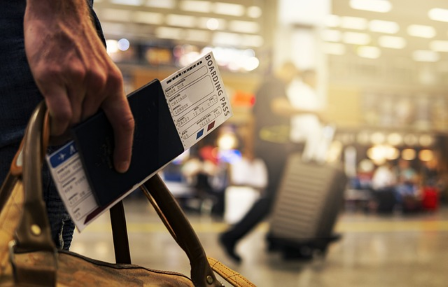
What to expect on arrival?
1-customs clearance in china.
• Customs Bureau officials must approve your pet for import after arrival
• China Customs Bureau does not require a pet import permit
• Pet owners must bring all original copies of the required vaccination and microchipping certificates, rabies antibody titre test reports and health certificates issued by the authorized veterinarian (or government-designated facility) in your originating country
• You may need to fill out a form after arrival with pet’s vaccination, microchip, and rabies antibody titre test information.
• Once documents are inspected and approved, your pet is cleared to enter China and can leave the arrival terminal
2-Quarantine
• If your pet does not meet the requirements for quarantine waiver, your pet must quarantine for 30 days at the government operated kennels available in Beijing or Shanghai
• If you are not certain that your pet may receive quarantine waiver, please fly into Beijing or Shanghai which have government-operated quarantine kennels
• Officially designated quarantine kennels are not available except in Beijing and Shanghai
• If you fly into other cities and your pet does not qualify for quarantine waiver, you will need to take your pet overseas.
3-Dog registration
• Dogs must be registered at the local Public Security Bureau (police station) that oversees your residential area
• Dog registration renewal must be completed annually at the police station
• Most cities have size restrictions for dogs and may only allow one dog to be registered to each household address
• Policies and enforcement may vary by city
• The local police station that oversees your residential address will have the final say on dog registration requirements and approving dogs for registration
• Beijing dog registration regulations are available on the ICVS website
Cats are not required to be registered upon arrival in China.
Departing from China with Pets:
• You may take your pet out of China if your pet meets PRC Customs Bureau requirements for export
• An international travel health certificate and exit permit from the PRC Customs Bureau is required to export pets
• It is never too early to begin export preparation even if you do not have a departure date or a confirmed destination country
• China is a rabies endemic country so fulfilling requirements for pets traveling overseas may take at least 6-8 months or more, depending on the destination country
• Keep your pet’s vaccinations up to date and unexpired
• China does not recognize 3-year vaccinations from other countries
• Pets must be vaccinated annually at officially designated animal rabies website vaccination hospitals. Please see the ICVS website for more information on officially designated animal rabies vaccination hospitals in China
Click here to register for the ICVS free online information sessions on Departing from China with Pets , hosted every weekend in English and Chinese.
Taking pets with you is very manageable with accurate information, sufficient time, and a budget to cover relocation expenses. It is never too early to prepare your pets for import to China, and having them microchipped, fully vaccinated and up to date on parasite prevention goes a long way in ensuring your pets are departure ready.
About the Guest Author
ICVS or the International Center for Veterinary Services is a full-service international animal hospital. Please contact ICVS for any questions regarding pet import and export to and from China.

Not registered yet? Signing up is easy!
As a member you can manage your favorite spots around town, upload housing ads, write reviews and more.
Forgot your password?
If you forgot your account password you might need to reset it.
- I’m Looking For …
- F&B : Restaurants , Bars , Clubs , Jazz , Live Music , Dives , Wine Bars Business : Lawyers , Financial Advisory , Business Consultancy , ... Living : Apartments , Serviced Apartments , Shared Apartments , Ayis Services : Tech Support , Laundry , Movers , Storage , Tailors , ... Education : Kindergartens , Primary Schools , Secondary Schools , Mandarin Schools Health : Emergency Rooms , Hospitals & Clinics , Dentists , Mental Wellbeing , ... Beauty : Hair Salons , Barbers , Massage , Waxing Kids & Family : Indoor Activities , Outdoor Activities , After School , Kid's Sports , ... Pets : Suppliers and Food , Hotels , Vets , Pet Sitting Sports : Dance Studios , Fitness Centers , Martial Arts
- General : Shanghai Essential Guide , Arrival Tools , Emergencies Finance : Setup Alipay , Setup WeChat Pay , Send Money Abroad Work : Find a Job , Change Jobs , Get Severance , Pay Income Tax Visa : Travel Visa Free , Get A Work Visa , Get a Green Card Logistics : Use Didi , Courier Something , Get a Driving Licence Home : Find an Apartment , Find a Nanny/Ayi , Fix Your Apartment Shopping : Buy Stuff on Taobao , Return Stuff on Taobao Life : Avoid Scams , Get Married , Get Divorced , Be Happy Pets : Get a Dog Licence , Take Pets Out of China Good Citizen : Donate Stuff , Donate Blood , Recycle , Volunteer Health : Book a Hospital , Get a Checkup , Get Health Insurance

- APP & SOCIAL
- Download our App
- Join a WeChat Group
- SMARTSHANGHAI
- Advertise With Us
- Back To Main Menu
- Subscriptions
- My Listings
- My Applications
Advertisement
List an Event
List a deal, list your venue, sell something, list an apartment.

[How to]: Take Your Pet Out of China

This article originally appeared in 2015. It was updated in February 2020, and re-written with current information in April 2024. Time's up! You've had your year or decade or lifetime in China and now it's time to go somewhere else. But along the way, you've picked up a little friend and you want Squirt or Pepper or Wooks to go with you to your next stop. (Assuming Squirt, Pepper or Wooks are cats or dogs. Rabbits, hamsters and chinchillas may qualify for special export permits, but these are new and it's not possible to DIY. Find a transport agent to help you out.) So, how do you get your pet out of China? Keep in mind this is actually a two-part question: how do you get your pet OUT of China; and how do you get your pet INTO your end destination? This article deals mainly with the first part — getting your pet out of China (Shanghai spectifically). For more details on additional import steps, you'll need to research the specific country or region you'll be traveling to for additional requirements like import permits and quarantine.
To break down the advice into easy steps and confirm the process for 2024, we spoke with Lee-Anne Armstrong, the Executive Director for Second Chance Animal Aid Shanghai, which maintains a helpful webpage with much of this information .
1 Get a Rabies Shot and Microchip

Take your dog or cat to get a rabies vaccination and a microchip. This can be done at any veterinary clinic that prints a Shanghai Immunization Certificate (a plastic card) for dogs and cats, in addition to providing the clinic vaccination book record.

All the branches of the official Customs Bureau partner clinic for pre-flight health check, (the Shenpu Pet Hospital ) will print a Dog Immunization Certificate card needed for a license but do not need to print a Cat Immunization Certificate card. The Shenpu's own vaccination book alone is accepted for a pre-flight cat health check.
For Dogs: If your dog does not have their license yet, this is an important step. Shanghai Customs requires dogs have a valid Shanghai license to issue an Animal Health Certificate for China export. ( read about how to register your dog in Shanghai here ).
Once you've done this visit, the rabies shot is valid for one year, and the following steps can be taken anytime within that year.
No comments yet
Comments get posted after being approved by our admins
2 Step 2: Waiting period

There is a minimum 30-day waiting period for all pets for all countries after the first step of rabies vaccination and microchip.
3 Step 3 For Many Countries: Rabies Titre Test

For all pets headed to the EU, Singapore, South Africa, Japan, the UAE and some other jurisdictions, they will require a rabies blood test. The blood draw to send the sample to an officially recognized PRC laboratory can be done at any clinic offering this service, including the Shenpu Pet Hospital ( 1,500 PRC lab, 2,800rmb for Japan) or Shanghai PAW (1,400rmb PRC lab). Ask your vet if they can send your blood sample to an approved lab for a rabies titre test.
After the blood draw date, there is a minimum waiting period that can be very lengthy (e.g. 3 months for the EU) before pets can travel.
The titre test's validity may be extended for entry into some jurisdictions (e.g. the EU) by keeping your pet's rabies vaccination up to date. Other places (e.g. Singapore) impose a short validity period before the test expires and would need to be done again.
Canada, Malaysia, Mexico, Thailand, and Russia are some of the countries that do not require pets from mainland China to have this test. Cats to the U.S. do not need a titre test, but dogs do.
NEW SINCE LAST UPDATE: The U.S. CDC requires dogs (but not cats) from the PRC have a rabies titre blood test as part of the CDC Dog Permit application process for entering the U.S. The waiting period after the blood draw is minimum 45 days, and the U.S. CDC limits the test validity to one year.
See details on the U.S. CDC dog import permit process at https://www.cdc.gov/importation/bringing-an-animal-into-the-united-states/dogs.html
Under the U.S. CDC Permit rules, dogs must only enter the U.S. via one of 18 approved airports.
4 Step 4: Book Your Flight

Pet owners should reserve their pet's transportation directly through their airline's China customer service hotline. Confirm a pet spot is available on your selected flight date(s) before finalizing a passenger flight booking.
Airline policy for how pets may fly varies, ie., small pet in the cabin with you (relatively inexpensive), checked as excess baggage in the hold (still reasonable) or as manifest cargo (thousands of dollars). Cargo and excess baggage are two very different transport options.
Your pet's height and weight determine where in the aircraft they can fly. SCAA warns owners of medium to large dogs and with multiple pets of US-based airlines' restrictive pet policies. United and Delta do not move pets as excess baggage, and American Airlines does not even allow cabin pets on China flights.
For multiple pets and / or animals that exceed cabin pet restrictions, owners should look to excess baggage options on ANA, Air Canada, Air France, Asiana, China Eastern, EVA Airlines, KLM, Korean Airlines, and Lufthansa instead.
NEW SINCE LAST UPDATE: In January 2022, the EU Animal Law was amended to require pets transiting through the EU to meet EU import requirements. This means that even for transit, pets should have a rabies titre blood test and 3 months waiting period before flying.
5 Step 5: Health Check Eight Days Before the Flight

Exactly eight days before your scheduled flight, you must take your pet for a health check (budget 700-800rmb) at the Xujiahui Lu branch of Shenpu Pet Hospital , the Customs Bureau veterinary clinic partner, within office hours of 9:00AM to 4:00PM.
Bring your vet clinic's dog or cats' vaccination book and plastic Immunization Card or your cat's Shenpu vaccination book, your dog license, your rabies titre test result (if required), your dog's U.S. CDC Import Permit, your passport, and your flight details. The Shenpu has also been asking for residence registration, so have that handy just in case.
After paying for the health check and submitting your documents, you will receive a receipt to pick up your export certificate from the Customs Bureau, generally 2-3 days before your flight.
The receipt has all the relevant information for picking up your certificate.
For Dogs: Shanghai has a one-dog-per-household registration rule. As a dog license is required by Shanghai Customs for export, owners traveling with more than one dog may get an export permit with a consent letter from the dog's registered owner. There is a simple form letter for this purpose to be presented at the pre-flight health check.
6 Step 6: Pick Up Your Animal Health Export Certificate Before the Flight

Go to the Huangpu Customs Bureau on the date listed on the receipt from Shenpu Pet Hospital to pick up your export certificate. Bring your passport. The Animal Health Certificate pick up location is currently atLan Sheng Mansion on Liu Lin road at Middle Huai Hai road ( 兰生大厦 , click here for details ). Opening hours are weekdays in two blocks of time; 9:00 – 11:00 AM and 2PM – 4PM.
Owners can give written permission, along with a copy of their passport, for someone else (who should also bring ID) to pick up their pet's certificate. The certificate is valid for 14 days from the date of issue.

I've heard that it's one pet per passenger/passport when leaving China. Is this true?
Lee-Anne Armstrong: There is no universal "1 pet per passport" rule. The number of pets an individual passenger can add to their flight ticket depends on their airline, destination import rules, and the pet's mode of transport (in the cabin, checked as excess baggage, or as manifest cargo). In the cabin, a passenger may generally only bring one small pet, and the total number of pets allowed in the cabin is limited. Very few airlines allow pets in the business and first class cabins.
NOTE: Owners of multiple pets should be especially careful about researching and seeking feedback on airline options before booking their own ticket.
How much will it cost?
Lee-Anne Armstrong: Airline fees for pets range widely depending on the type of transport. For in the cabin, fees are generally in the 100-175usd range. For crates checked as excess baggage (not an option on U.S. carriers) costs can vary depending on size of crate and are around 300-600usd. Manifest cargo is a special category of pet transport where a pet agent is needed for Customs clearance. Cargo is very expensive — thousands of dollars. Cargo may be required for pets entering by air (e.g. the U.K., UAE) and all unaccompanied pets fly as Cargo. See here for Delta information , here for Korean Air's pet policy and here for KLM .
I've heard airlines have blackout dates for pets because it's too hot or too cold for them. True?

Lee-Anne Armstrong: Chinese airlines have hot weather bans for their excess baggage transport. They do not offer an in-cabin pet option. Air Canada has similar hot and cold weather restrictions for excess baggage transport, while in-cabin moves remain available.
What restrictions are there on the pets?
Each airline publishes its own pet travel policies. Cabin pet carriers, which must fit under the seat in front of you, vary in maximum size by airline and aircraft. Pets in cabin bags usually count as your one carry-on item.. Delta does not accept pets on flights with an average flight time of greater than 12 hours. Lee-Anne Armstrong: It can be a problem for people in China who only call their airline's overseas hotline or do not expand easily-missed restrictions sections on the airline's website.. It's best to enquire about pet transport bookings with your airline's China office directly.
Are there restrictions on certain breeds?
Yes. Among other restrictions, ‘strong' dog breeds may be banned or require special crates and brachycephalic (i.e. flat-faced) breeds are often prohibited from flying or may be permitted only in cabin or only in cooler weather. Breeds to pay attention to include: Dogs : Affenpinscher, American Pit Bull Terrier, Boston Terrier, Boxer, Brussels Griffon, Bulldog, Cane Corso, Chihuahua, Chow Chow, Dogo Argentino, Dogue de Bordeaux, English Toy Spaniel (King Charles Spaniel), Japanese Chin, Lhasa Apso, Newfoundland, Pekinese, Pug, Rotweiller, Staffordshire Bull Terrier, Shar Pei, Shi Tzu, Tibetan Mastiff and Tibetan Spaniel. Cats : British Shorthair, Burmese, Exotic Shorthair, Himalayan, Persian, Scottish Fold
Do I have to do this on my own?
You don't have to but you certainly can handle all these steps on your own. If you have a budget for the convenience of a profressional agent, or if your destination or airline requires pets travel as manifest cargo or owners plan to fly separately from their pet then IPATA, the International Pet and Animal Transportation Association , has a useful online list of member companies to search.
Where can I get more information?
See SCAA's detailed information about in-cabin transport, excess baggage transport and cargo transport here , as well as special requirements for the U.K.
8 Pet Relocation Agents

For pet transport, there's a wide variety of people out there calling themselves agents. Second Chance Animal Aid suggests owners start a search for pet relocation agents first through personal recommendations if friends have used an agent and are happy with their service, getting pets home safely and comfortably. A good starting point is the International Pet and Animal Transport Association (IPATA) . IPATA is a non-profit trade association whose members are dedicated to providing the highest professional pet moving services. Some IPATA-member pet transport agents, whose business focus is purely on domestic and international pet moves,SCAA is familiar with the following agents from adopters' positive experience:
- Globy Pet Relocation Shanghai/Beijing/Guangzhou http://www.globypetrelo.com
- Kevin Home Express Shanghai and Beijing http://www.kevinhomeexpress.com
- Shanghai M&D Pet Service http://www.mdpet.com.cn
- PawPal Pet Relocation Shanghai
--- With so many changes announced so frequently over the past 2-3 years, pet owners should use travel advice and experiences as a good starting reference, and double check policies are current.
TELL EVERYONE
ADVERTISEMENT

_ YOU MIGHT ALSO LIKE

Wang Ayi, Shanghai's Dog Whisperer

Hello, Kitty: Rescuing Strays

Communities: SCAA
SmartShanghai.com is an independent media publication dedicated to honesty and editorial transparency. We are for Shanghai residents, written by a team of long-term, opinionated and knowledgeable writers and editors. We never give an opinion or recommendation that we wouldn’t also share with our own friends and family.
- List An Event on our curated editorial events page
- Post a Job on Shanghai's best English jobs boards
- Sell Something using our Buy & Sell classifieds
- List Your Business in Shanghai's largest English directory
- Sell Tickets using our SmartTicket ticketing service
All material is copyright of SmartShanghai.com Made in and for Shanghai since 2003 | 沪ICP备08111777号-9
Sign in to sync your favorites across devices
Save to favorites, favorite added, thanks for your interest in our services.
Please reach out to our sales team through a contact channel below:

Thank you for your feedback
Our editors and admins will review your message and respond to your inbox
Report Wrong Information
Report a technical bug, general feedback, promote your business, general enquiry.

What To Know About Traveling Internationally With Your Pets
T raveling internationally with your pet can be a great experience. For one, most of us consider our pets family, so exploring the world or vacationing with our quadrupedal companion can be an exciting proposition. But in some circumstances, it may be difficult — if not impossible — to travel internationally without your pet. Boarding costs and pet-sitting fees can be astronomical, and without calling in favors from family or friends, you may not be in a situation to leave your pet stateside for an extended period of time.
Knowing how to travel with a dog internationally (or cat) wisely can be the difference between a rewarding experience and a hassle-plagued trip. Taking your pet requires forethought, in-depth research, and savvy trip planning. While the idea of traveling with your furry confidant may be appealing, it's also a big responsibility with its own unique considerations, probably dictating what airlines you take, where you plan to stay, and the experiences you'll have.
That said, the reward of sharing your travels with your pet can make the effort, expenses, and sacrifices well worth it. But to avoid major problems, you'll need to be well-acquainted with everything traveling internationally with your pet entails.
Finding A Pet-Friendly Flight
To begin planning your international adventure, it's imperative to research the various pet policies across different airlines. Most major airlines allow small dogs and cats to fly in the cabin with you, as long as they're placed in an FAA-approved pet carrier that fits comfortably under the seat. If you're the pet parent of a small dog or cat, you'll still need to check your flight before purchasing a ticket. Typically, airlines only allow a certain amount of pets on a flight, so you need to ensure a spot's available for your pet before purchasing your own ticket.
If your dog isn't small enough to fit under the seat in front of you, things get a bit more complicated. The only U.S.-based carriers that allow dogs to fly in the cargo hold are Alaska Airlines, American Airlines, and Hawaiian. Fortunately, international airlines tend to be a bit more accommodating. Air France, Swiss, Turkish Airlines, Lufthansa, TAP, SAS, British Airways, Alitalia, KLM, and Japan Airlines all currently allow larger pets to fly in cargo.
Pet Policies And Alternative Transport Options
It's important to note that some, but not all, airlines also have breed restrictions for the dogs they allow to fly in the cargo hold . These restrictions are typically imposed on short-nosed breeds, such as boxers, bulldogs, Boston terriers, and others, as these Brachycephalic breeds are prone to breathing difficulties. Overall, it's a good idea to contact the airline directly concerning any questions regarding breed restrictions.
If you're unable to find a flight that can accommodate you and your pet, whether due to breed restrictions or other factors, there's still hope. You may have the option to ship your pet through a commercial transport company, but you'll need to ensure the company is part of the International Pet and Animal Transportation Association (IPATA), a regulated organization that adheres to ethical safety standards.
If you are trying to travel with your pug or bulldog, IPATA works with airlines and transport companies that may accommodate your pet. IPATA created a Brachycephalic Certification Program that allows these types of breeds to fly after passing a fit-to-fly assessment. These specialized assessments can be conducted by a certified veterinarian, and the results are given to the airlines and companies partnering with IPATA, helping to ensure the safety of your dog.
The Cost Of Flying With Your Pet
Airline pet fees aren't cheap. If your pet is small enough to fly in the cabin, the fees can be up to a few hundred dollars one-way, but these prices increase dramatically if the pet is traveling in the cargo hold. The cost will depend on the airline, the route (with or without layovers), and the size of the crate.
In most cases, when traveling with a pet, it's wise to spend up for a direct flight versus trying to save with layovers if your pet is in the cargo hold. But if your itinerary must include a layover or multiple, many airlines require a three-hour minimum time window between your connecting flights. This gives the airline ample time to feed, give water, and walk your dog to use the bathroom, but fair warning, these services aren't cheap. It's always a good idea to check with the airline to learn more about their specific policies.
If a direct flight isn't possible, then try to at least stick to the same airline. In simplest terms, changing airlines in a foreign country will require you to claim your dog from cargo, then pay another pet fee to the new airline. You'll also need to clear your dog through customs.
Paperwork And Health Assessments
Before you depart, you'll need to make sure your pet's paperwork is in order. While countries differ in their requirements, most require the following at minimum. First, you'll need to take your pet to a veterinarian to receive an international health certificate no more than 10 days before departure (or entry to the foreign country). You'll also need proof of a rabies vaccination taken within the last year for most destinations, as well as governmental export paperwork.
In addition, some countries require blood titer tests for rabies and proof of parasite prevention treatments. You need to research the requirements carefully of the particular country to ensure you have the proper paperwork, as the requirements are not flexible. Your pet will also require an ISO-compliant microchip, which is the world standard. If you need to update your pet's vaccinations, many countries require that the microchip be implanted before the pet receives its vaccinations. Finally, while most countries do not require a quarantine period upon entry, some rabies-free and island nations do, such as Australia, Japan, Hong Kong, and Iceland. The length of quarantine varies by country.
Prepping Your Pet For Flight
Along with knowing how to travel with a dog internationally in financial and regulatory terms, it's equally as important to prepare your pet for the trip, especially if it's a long-haul flight. For instance, if your pet isn't used to being in a crate, then it's a good idea to acquaint your pet with one for a few weeks before the flight. This could mean requiring them to sleep in a crate or leaving them in one for periods of time.
Same idea with puppy pads. Whether they're flying in the cabin or the cargo hold, your fur buddy will probably be expected to use a pet relief area at some point. Flying can be a stressful experience for a pet, but introducing them to a crate and pads beforehand may help the situation.
While traveling internationally with a pet can be costly and time-consuming, it can also be an extremely rewarding experience after the rigmarole, as long as you plan carefully and know what to expect.
Read this next: Insider Hacks And Little-Known Facts: 12 Secrets Of Inflight Beverage Service
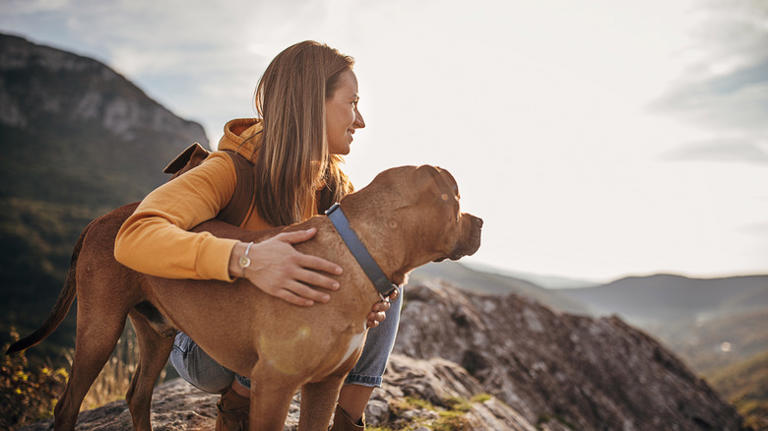
Chinese zoo under fire after dyeing dogs to resemble pandas
HONG KONG — A zoo in China has been accused of trying to deceive visitors with a pair of dogs dyed black and white to look like panda bears .
Videos circulating on Chinese social media show the two “panda dogs” in an exhibit at Taizhou Zoo in the eastern province of Jiangsu that opened on May 1. Though the animals are patterned to look like pandas, which are endemic to China and an international symbol of the country, their wagging tails give them away.
Zoo officials told Chinese state media that they were Chow Chows — a fluffy dog breed originally from northern China — painted black and white to resemble giant pandas, adding that they had clearly advertised them as “panda dogs” and did not make any false claims.
The dogs are still at the zoo, officials told NBC News by phone on Friday, where the number of people coming to see them remained “at a normal level.”
The zoo, which does not have real pandas, was nonetheless criticized by state media and others for misleading visitors and mistreating the dogs.
“It is not funny at all to dye Chow Chow dogs to attract tourists,” one commenter wrote on the social media platform Weibo. “Their fragile skin and naturally thick coats make them susceptible to skin diseases.”
Zoo officials defended the exhibit, saying the dogs had not been harmed.
“Normal people dye their hair,” a spokesperson told Qilu Evening News. “Dogs can dye their hair, too. It’s the same as hair.”
This is not the first time that “panda dogs” have set off social media discussion in China.
In 2019, a dog cafe in the southwestern province of Sichuan raised animal rights concerns with its six Chow Chows that were also dyed to look like the bears.
In 2020, in the same province, a “panda” being walked by a woman in a video that went viral was revealed to be a dyed Chow Chow.
Other zoos in China have also been accused of having fake animals, often dogs they tried to present as wolves or African cats.
Last July, a zoo in the eastern province of Zhejiang denied that its Malayan sun bears were human beings in disguise after a video of one standing like a person went viral. Experts debunked the claim and the zoo said there was no way a person in a fur suit would be able to withstand such high summer temperatures.
Larissa Gao is a fellow on NBC’s Asia Desk, based in Hong Kong.
China’s Golden Week Travel Signals a Revival. Plus, Why U.S. Travel Is Still Lagging
Peden Doma Bhutia , Skift
May 30th, 2024 at 12:42 AM EDT
China’s outbound travel is coming back, driven by favorable visa policies, increased airline capacity, and a growing interest in diverse global destinations. However, challenges remain, particularly in travel to the U.S.
Peden Doma Bhutia
In a rebound of international travel, over 1.5 million Chinese citizens embarked on outbound trips during the recent Golden Week holiday , marketing technology firm China Trading Desk told Skift.
This surge points to a significant revival in global travel following the easing of pandemic-related restrictions.
The relaxation of visa policies between China and several countries has played a crucial role in this uptick. During the Golden Week in late April and early May, the growth rate of inbound and outbound bookings outpaced domestic tourism, Trip.com Group told Skift.
Popular Destinations and Emerging Trends
According to data from Trip.com Group, Chinese tourists visited nearly 200 countries and over 3,000 towns worldwide during the Golden Week period.
Thailand emerged as the top destination, with over 215,000 Chinese tourists between April 27 and May 4, according to China Trading Desk’s data. Factors such as visa-free entry offer by Thailand, shorter flight durations, and cost-effectiveness compared to other destinations have driven this trend.
While strong, the numbers still haven’t reached pre-pandemic levels, said Subramania Bhatt, CEO of China Trading Desk.
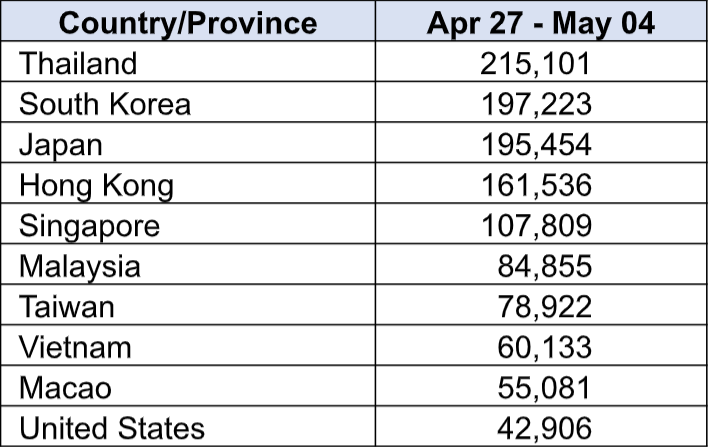
The popularity of outbound travel is further evidenced by Ctrip’s report of a 190% year-on-year increase in the number of outbound tourists. Alibaba’s Fliggy also noted a near doubling in outbound travel bookings during the five-day holiday, with per capita spending on outbound travel surpassing 2019 levels significantly.
Alipay transactions reflect this increased spending, with a 77% rise in overseas markets during the initial days of Golden Week, particularly in destinations like Thailand and Malaysia.
Challenges in US-China Travel
Travel to the U.S. still faces hurdles , with flight capacity between the two countries around 25% of pre-Covid levels. During the 2019 Labor Day holiday, 70,000 travelers journeyed from China to the U.S., but most recently it was around 42,000.
Bhatt cited several reasons for this:
- Limited Flight Availability: There’s a slower resumption of direct flights and connectivity between China and the US, impacting the ease of planning trips.
- Visa Processing Delays: Longer visa processing times have been a deterrent, likely due to staffing issues and backlogs caused by the pandemic.
- Geopolitical Tensions: Ongoing political tensions between China and the US may make some potential travelers hesitant.
- Concerns Over Racial Treatment: There is apprehension about the treatment of Chinese individuals in the U.S., which can influence travel decisions.

Airline Capacity and Pricing Trends
Though limited, there has been a gradual restoration of airline service and that has helped. Fliggy said that the average price per person for international air tickets dropped by more than 10% compared to the previous year.
The preference for Asian destinations remains strong, with 9 out of the top 10 outbound destinations being in Asia. Bhatt attributed this to the ease of travel, increased flight availability, and visa-free access in many Southeast Asian countries, as well as Hong Kong, Taiwan, and Macau.
Europe continues to attract Chinese tourists, with over 100,000 travelers heading to European countries excluding the UK during the holiday season, according to China Trading Desk’s data. Trip.com reported notable increases in travel to Spain, Turkey, Austria, Slovenia, Italy, and Georgia, with year-on-year growth exceeding 1.5 times.
Domestic capacity in May still accounts for 92% of all seats to, from and within China this month, with international making up the remaining 8%, according to aviation data firm OAG .
Shifts in Travel Preferences
There is a notable shift towards exploring less traditionally frequented destinations. Austria, Turkey, Morocco, and other less traditionally frequented destinations by Chinese tourists saw the fastest growth rates in bookings, indicating a shift towards exploring new and diverse destinations
Fliggy also reported that bookings for long-distance travel to places like Austria, Turkey, Morocco, Russia, Portugal, Georgia, Egypt, Spain, Kazakhstan, and Brazil quadrupled compared to the previous year.
Additionally, Trip.com group noted significant increases in travel to Middle Eastern destinations such as Oman, Saudi Arabia, and Kuwait, with numbers more than tripling year-on-year.
Saudi Arabia and Qatar are set to increase the number of direct flights connecting China and Hong Kong, capitalizing on the resurgence of Chinese tourists. Having welcomed 140,000 Chinese tourists last year, Saudi Arabia aims to attract 5 million Chinese visitors by 2030.
The Daily Newsletter
Our daily coverage of the global travel industry. Written by editors and analysts from across Skift’s brands.
Have a confidential tip for Skift? Get in touch
Tags: alibaba , alipay , asia monthly , china , china airlines , china outbound , coronavirus recovery , ctrip , fliggy , golden week , trip.com group
Photo credit: Fliggy reported that bookings to Turkey, Morocco, Georgia, Egypt and Kazakhstan have quadrupled compared to the previous year. Rachel Claire / Pexels
32 tips for traveling with pets
Taking your pet on your travels can be life-enhancing – here are some tips for traveling with pets.

Traveling with pets can be both a joy and a nightmare. While it is wonderful to share our adventures with our loyal four-legged companions, there are a lot of things to organize before going on a trip. But don't feel overwhelmed we've rounded up some top tips for traveling with a pet.
Naturally, the logistics will depend on the pet. A small animal kept in a cage has different requirements than dogs and cats. Some pets, particularly cats, are true home-birds and may be happier left at home with someone booked in to look after them. The simplest choice is usually to book your pets into a boarding facility.
However, some of our pets just love to come with us wherever we go. The mere sight of a suitcase or mutterings about packing will send them into a depression. They may even try to get in the suitcase with some of their best dog toys to ensure they come too. This particularly applies to dogs, who long to be at the heart of the action, wherever that may take them. But everyone will enjoy the vacation all the more if you know how to travel with a dog .
Good preparation is key. If you have all the Is dotted and Ts crossed, you are set for a great adventure with your pet at your side. Let’s take a look at some of the considerations you need to make.
1. Visit the vet

Schedule an appointment with your vet to make sure that your pet is in great shape before the trip, and up to date with all vaccinations. If your pet is on any regular medication, you’ll need to stock up with sufficient supplies.
Some airlines will require a current fit-to-fly health certificate, so find out if this is needed and book it before the veterinary check-up.
2. ID and microchip

In the UK, since 2016 it has been a legal requirement that all dogs are microchipped. They should also wear a collar with identification details to enable their owner to be located if the dog is lost. Enforced microchipping will also come into force for British cats from July 2024.
PetsRadar Newsletter
Get the best advice, tips and top tech for your beloved Pets
In the US, microchipping is the law in certain states. While collars and tags are not a legal requirement, both forms of identification are highly recommended. This is particularly important given that you will be traveling your pet outside its familiar local area, in case it gets lost.
Take a current picture of your pet with you, so that you can show police and vets if you do lose them.
3. Research pet-friendly accommodation
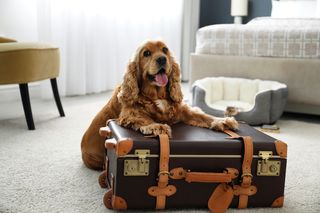
Not all hotels, BnBs, and apartments accept pets, so always check while planning your trip. Some accommodation providers charge an extra fee for pets because of the additional cleaning required.
There may be rules, such as that your pet is kept in a crate while you are not in the room; that they are not allowed on the furniture, and so on. Some may have restrictions on the size of the dog, or which type of pet you bring.
4. Pet carrier
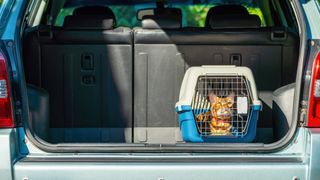
A pet carrier is the safest way to transport your pet, as well as giving them a secure haven to rest in during what can be a stressful time traveling. Don’t skimp on quality – your pet may be restricted to this crate for long periods during travel, so it should be sufficiently roomy, well-ventilated, and sturdy. Investing in one of the best cat carriers or the best dog crates is well worth it.
If you are taking your pet on an airplane, check that your crate complies with airline regulations.
5. Get them used to the carrier

The first time that your pet uses his carrier should not be on the day of your trip. Buy the carrier well in advance and familiarize them gradually, making it a really inviting place with blankets, their favourite toys, and some of the best puppy treats . Leave it open the first few times you try, so that they don’t feel claustrophobic and can come and go as they please. Once they are relaxed and content inside, feeling like it is a good place, then you can shut the door and reward them.
6. Take familiar items

If your pet has never left home before they are likely to take some time to settle into their new surroundings. They will be pacified by your presence, but it will also help to take their blankets and any familiar toys as these will smell of home and provide comfort.
7. Practice car rides

Owners vary on how often they take their pet in the car with them, but particularly for those who don’t travel often, it’s really important to familiarize them with the motion of traveling and the sensation of being in the car. Assuming you will be using a pet carrier, being comfortable in this needs to be well established before you go off on vacation so that jumping in the car for a trip feels like second nature – and a chance for an adventure with you.
Take them to places they will love, like one of the best dog walks in the US for a couple of hours’ walk, so they associate the car with good things.
8. Make the car secure and safe

You wouldn’t drive your child around without a seatbelt, and nor should you travel with your pet without appropriate restraints. A pet seatbelt/harness or a carrier is ideal.
Not only is it risky for your dog in case you have an accident or have to brake sharply, but it’s also dangerous to have a loose dog – especially one that doesn’t sit still – distracting the driver. So having them in the best dog car harness is the safest option for everyone.
9. Pack essentials

Depending on the length of your journey, it’s advisable to have a little travel bag with all your pet essentials for the duration. This will include water and a vessel for drinking out of, any medications, treats, and sufficient food for the journey. However, you should not feed much to pets either before or during the journey as it may make them uncomfortable or cause motion sickness.
Always pack a little extra of everything in case you suffer a breakdown or get caught in a traffic jam.
10. Assemble pet first-aid kit

Pack a first-aid kit so that you can attend to any cuts and scrapes while you’re out and about. You can buy a ready-made kit with all the essentials, or assemble one yourself.
This should include items such as a tick remover, tweezers, saline and antiseptic solution, pet wrap, bandages, scissors, and an ice pack.
If your pet is on any regular medication, don’t forget to include a sufficient supply.
11. Check the weather forecast

Are you ready for the weather at your destination? Check the weather forecast and pack accordingly.
If it‘s going to be wet, you may need to take extra towels (the hotel won’t thank you for drying a muddy dog with theirs), a waterproof coat, and a drying robe. Snowy weather might necessitate a warm coat if they are not used to sub-zero temperatures unless you have one of the best dog breeds for cold climates .
Hot weather should make you assess your plans. If you had long walks scheduled in the middle of the day, you may want to move these to dawn and dusk when it’s cooler. Take travel doggy water bottles so that your dog can drink while out and about. You can also take a parasol for shade, and a cooling jacket or mat for pets. Dogs may also benefit from shoes to prevent them from burning their pads on the pavement.
Remember that if the climate at your destination is very different from what your dog or pet is used to, they will need time to acclimatize and should not be thrown into a busy program of activities while they settle in.
12. Plan rest breaks

If you have a long drive, plan rest breaks where you can stop, let your pet out of its carrier, have a drink, stretch, and go to the bathroom.
Vets typically advise that any trip over four hours should incorporate rest breaks every two to four hours for 15 minutes or so. Younger animals may need to stop more frequently.
Let’s face it, you’ll probably want to stop too!
13. Research vets at your destination and along the route

Always prepare for the worst and hope for the best. By doing some research to find out contact details, including out-of-hours, for the nearest recommended vets both at your destination and along the route, you will have peace of mind that if your pet should suffer an injury or illness while you’re on vacation, you know exactly whom to call to get the best possible help.
Chances are you won’t need it, but not being prepared will add another layer of stress you don’t need if there is an emergency.
You can search a list of veterinary and pet emergency hospitals in the US at the American Animal Hospital Association .
14. Know pet policies on your chosen transport

Unless you are planning to travel exclusively by your own car, check the pet policies on all modes of transport you want to use. For example, some taxis allow pets, some don’t. Many will charge an extra fee for cleaning.
Ferries often allow dogs, but they usually stay in the car on the vehicle deck or have a specific kennel area.
Airlines have specific regulations depending on whether it is a national or international flight, and so do trains, buses, and trams. Many require the pet to be crated, and some of these vary in rush hour, or according to the size of the pet.
15. Update contact information

Have you checked that your pet’s microchip is correctly linked to your current address? Many owners never change it from the breeder to which it was originally registered.
Does your dog tag have your current phone number and address? Make sure these are all updated well in advance of your departure date to avoid any last-minute panic (or – at worst – your lost dog not being able to be reunited with you).
16. Research pet-friendly attractions

Not every place that humans want to visit is up your pet’s street. Furthermore, many attractions do not welcome dogs. This includes some areas that you might imagine would be perfect dog-walking territory, such as some national parks and beaches. Luckily, there are many options for the best places to take your pet on vacation to make things easier.
You shouldn’t leave your dog back at your accommodation all day, especially in an unfamiliar place, so always check while you are planning your adventures that your dog will be welcome to join you, and be aware that it will often have to be on a leash.
17. Stick to your pet’s routine

Long journeys often throw our routines out of whack, and that’s normal, but once you have arrived, try to get straight back into the normal schedule so that your pet knows what to expect and when.
He may be feeling very unsettled in the new environment, possibly a different climate, and feel out of sorts after long hours traveling, so getting back on track will help bring some order back into his life. Food, hydration, exercise, and sleep should help put him back on schedule.
18. Make your holiday accommodation pet-safe

The chances are that at home you have various barriers and locks to keep your pet in the right place – or at least a trained understanding that he sticks to certain areas (for example, not on the couch or up the stairs). But your temporary accommodation is unlikely to be rigged up exactly to suit your usual arrangements. Perhaps there’s easy access to a front door that opens out onto a busy road, or a balcony with bars wide enough for a pet to slip through.
When you arrive at the accommodation, go around and note all the potential danger areas, and work out how you can make them safe, for example by limiting the pet to a certain room or blocking an entrance.
19. Pack for comfort

It can be tempting when trying to keep the baggage under a certain limit to leave luxuries behind. However, your dog will settle and sleep best if given a familiar and comfortable bed to rest on, it might be worth considering one of the best dog travel crates.
The floors may be hard, rather than carpeted, and travel crates are typically not padded – so make sure you have plenty of comfortable bedding. Likewise in the car, give him plenty of padding so that he is not stiff after a long journey with restricted movement.
20. Take grooming essentials

Grooming might not be top of your to-do list while on vacation, but you don’t want to find you need to use your own hairbrush to detangle mats out of your dog’s ears. Take a selection of grooming essentials so that you aren’t caught short. For instance, some dog shampoo in case he rolls in something foul-smelling, a comb to get rid of mats, and some of the best dog nail clippers.
And of course, don’t neglect their dental hygiene. Dogs’ teeth should be brushed daily, so take one of the best toothbrushes for dogs and toothpaste.
Another tip is some spare towels, as your accommodation provider will not thank you for using their towels to dry off your dog.
21. Cleaning equipment and poop bags

Unfortunately, accidents happen, especially in young and elderly pets. Any pet can make a mistake when they are in unfamiliar surroundings and are not sure where and when to do their business. More irritatingly, some pets – male dogs in particular – decide that a new place is a territory that needs to be marked, so be on the lookout for this as they will need close supervision. The American Kennel Club has advice on curbing the issue of dog marking .
Take cleaning equipment so that you can ensure your temporary accommodation is left smelling sweet and looking clean. And don’t forget the poop bags!
22. Hydration

While it’s not advised to feed your pets while they are physically traveling, water is essential, so ideally have water available for them during the journey or offer it regularly. You can buy travel water bowls that don’t spill.
Dogs on average drink up to 1oz of water for every pound of bodyweight a day. Cats drink far less. So a 60lb Labrador will need up to five cups of water.
Without sufficient water, they will become dehydrated and prone to overheating. They are likely to require more water in hot weather than cold.
23. Research pet-friendly restaurants and cafes

It’s wonderful to run into a cafe for a cappuccino or a beer after a long walk. But check beforehand that dogs are allowed. Many do welcome dogs and even have a water bowl for hydration and treats to show they’re dog-friendly.
Fancier restaurants may not be so keen on dogs, and it may also depend on the size. A chihuahua is less likely to cause a stir than a mastiff.
24. Prevent motion sickness

Many dogs suffer motion sickness, particularly younger ones, and they often grow out of it by the time they are a year old. You may be able to desensitize them by regular very short trips gradually building up.
Travel your dog on an empty stomach, as this will help reduce nausea. Supply water, and keep the temperature cool.
For cats, desensitization can be trickier, so may take longer to condition them, but the same goes – short trips building up, cool temperatures, and withholding food before a journey.
For both dogs and cats, there are also medications available for preventing motion sickness, so consult your vet to see what is recommended. Most sedatives are not permitted on airlines, so make sure you are aware of the regulations.
25. Sedation

While it may be tempting to administer a sedative to your pet to enable them to sleep through the journey and reduce stress levels, the American Veterinary Association advises against this, and in fact, airline regulations usually prohibit it. This is because sedatives affect coordination and balance, which your pet may need during a bumpy ride.
However, tranquilization is an option because it reduces anxiety without causing drowsiness, so this may be considered in consultation with your vet.
26. Temperature control

On flights, pets are not permitted to fly in very hot or very cold temperatures for the sake of their safety and wellbeing. This may affect your destination or the season in which you travel.
According to the United States Department of Agriculture , temperatures should not exceed 85ºF or be cooler than 45ºF for a period of more than four hours.
During travel in your own personal transport, keep the temperature relatively cool as this will help reduce stress levels and the chance of dehydration, both of which will make for an unpleasant and uncomfortable traveling experience for your pet.
Pets should never be left in cars, particularly in hot or sunny weather as the inside temperature can rise very quickly with fatal results.
27. Unfamiliar noises

As some pets are more anxious than others, you may find yours is scared of the unfamiliar noises in your temporary accommodation. Perhaps there are thunderstorms, a loud road nearby, or wildlife. The best way to help them deal with this is to distract them, often by playing with them, engaging them in one of the best dog puzzle toys , or their own squeaky toy that makes a familiar noise. Pack these sorts of distractions to bring out when you need them.
28. Research quarantine requirements

If you are crossing any international borders, check quarantine requirements months in advance. Many countries require your pet to have had specific vaccinations. The big one is rabies – some rabies-free countries, such as the UK, require vaccination and health checks in the 24-hours before traveling from certain countries, and compulsory quarantine from other countries regardless of vaccination status.
29. Respect other travelers

You clearly adore your pet, otherwise, why would you take the trouble to travel with them? However, as with small children, many other travelers do not feel the same way. Some will have boarded their pets so they can enjoy a vacation free of barking and dog poop!
So be respectful of their privacy and don’t let your pet encroach on their personal space. You should keep them on a leash whenever necessary, curb any barking and always clear up their poop.
30. Be patient and calm

Traveling is stressful for everyone. But at least the humans know where they are going, and how long the journey should take. Pets are at the mercy of our decisions. They are likely to feel some level of stress during the journey, so help them to stay settled by being patient and calm yourself, and the vibes will comfort them. You’re in control, and they will draw on that.
31. Pet-friendly apps

There are stacks of great apps to help you plan your itinerary, where dogs are welcome, local emergency services, nearby dog walkers and even put you in contact with other pet owners who can give recommendations and support.
In the US, BringFido and BarkHappy are recommended for dog owners; while Rover is useful for both dog and cats.
32. Pre-travel exercise

Give your dog plenty of exercise the day you travel so that he will be happy to lie down and enjoy the enforced resting period during the journey, especially if your dog is one of the high energy dog breeds .
Play with your cat, with one of the best automatic laser cat toys or other toys so that they have had sufficient stimulation.
Martha is an experienced journalist working in both print and digital media. She specializes in the canine, equine and rural sphere where she has covered a wide range of topics from cloning animals and the ingredients for a perfect yard dog, to helping owners find the best canine GPS trackers on the market. When she’s not busy writing about dogs and horses, she’ll be found either aboard a horse or looking after the menagerie of pets in her care.
Trainer reveals three loose-leash training mistakes you want to avoid making (and we're guilty of number two!)
Pet thieves could face 5 years in jail under new law
Dog who ran off on vacation 200 miles away is reunited with owner three weeks later
Most Popular
- 2 Trainer reveals three loose-leash training mistakes you want to avoid making (and we're guilty of number two!)
- 3 32 best cats for seniors
- 4 32 types of large breed cats
- 5 Pet thieves could face 5 years in jail under new law
Special Features
Vendor voice.
China shows off machine-gun-toting robot dog and its AI-powered puppy
Training exercises test suitability for both reconnaissance and lethal kinetic action.
China has shown off a pair of robot dogs – one of them toting a machine gun and the other powered by AI.
State broadcaster China Central Television (CCTV) posted news of the digital hounds earlier this week.
Both strongly resemble Boston Dynamics's "Spot" robo-canine. The larger model, said to weigh in at 50kg (110¼ pounds), is shown carrying a machine gun and advancing while being remotely operated by a Chinese soldier who causes the weapon to fire.
"It can serve as a new member in our urban combat operations, replacing our members to conduct reconnaissance and identify enemies and strike the target during our training," explained Chen Wei, a Chinese soldier.
The other computerized canine, a lightweight 15kg (30 pounds) beast, is said to have the ability to find its own way around a battlefield thanks to AI, and to "transmit information about on-site obstacles such as wire fences, discarded tires, and tire spikes."
The dog can also jump, and move forward and backwards. Lying down is another option – perhaps to duck under incoming ordnance, or ask for a belly rub.
- Throwflame launches fire-spitting robo-dog from Hell
- CERN is training robot dogs to spot radiation hazards at Large Hadron Collider
- How do you teach a robot dog new tricks? Throw it a string of hex, a crayon, and a canvas
- Food robots delivering bombs? Oregon State campus shut down by 'prank'
Here's the vid of the puppy, and some drones the Chinese military has implemented for other tasks.
Youtube Video
China's machine-gun-toting robo-dogs are not unique, nor is its approach to the binary beasts. the US military has explored the same idea and, like China, wants a human to pull the trigger rather than letting robot dogs with machine guns off the leash.
That approach puts both nations in alignment with current international sentiment that autonomous weapons are simply too dangerous to be unleashed – a mistake made by an AI-controlled weapon could escalate conflicts and result in more harm to humans.
China's military didn't reveal whether its robo-dogs are considered ready for frontline action, but their use in joint military exercises with Cambodia suggests that scenario is under active consideration.
Just how useful the creatures will be is, however, questionable. China Central Television reported the beasts' belly-mounted batteries can power the machines for between two and four hours – not a vast amount of time in a real conflict. ®
Narrower topics
- China Mobile
- China telecom
- China Unicom
- Cyberspace Administration of China
- Great Firewall
- Large Language Model
- Machine Learning
- Neural Networks
- Semiconductor Manufacturing International Corporation
- Tensor Processing Unit
- Uyghur Muslims
Broader topics
- Self-driving Car
Send us news
Other stories you might like
Ai smartphones must balance promise against hype and privacy concerns, china lands probe chang'e-6 on the far side of the moon, us, china agree to meet in switzerland to discuss most pressing issue of all: ai use, time for a fresh approach to compute architecture.
Taiwan's new president wants to upgrade from 'silicon island' to 'AI island'
Aleph alpha enlists cerebras waferscale supers to train ai for german military, lawmakers advance bill to tighten white house grip on ai model exports, palantir bags $480m from pentagon to inject battlefield ai into the entire military, china creates llm trained to discuss xi jinping's philosophies, two weeks ago, alibaba cloud bragged its ai was soaring. now it's slashing prices, china's top rideshare boss vacates her role, microsoft's deal with uae's g42 sparks fears over true destination of ai exports.
- Advertise with us
Our Websites
- The Next Platform
- Blocks and Files
Your Privacy
- Cookies Policy
- Privacy Policy
- Ts & Cs

Copyright. All rights reserved © 1998–2024

IMAGES
VIDEO
COMMENTS
The date of departure from the United States. Whether the pet will be traveling alone, as cargo, or with a person in the cabin of the plane. Note: If you're traveling with a pet bird or exotic animal, you may need to work with additional agencies, such as the U.S. Fish and Wildlife Service (1.41 MB) and Centers for Disease Control and Prevention.
Because of the health risk, China only allows pets to enter its borders according to the following strict regulations. Only one dog or cat per person is allowed; no other animals. If the animal type or number is outside of regulations, for example, if you bring a hamster or two cats or dogs, your pet will be deported or destroyed.
Air Travel Pet Container Regulations. ... Passengers carrying pets as checked baggage should contact China Airlines in advance. Pets and pet containers may not be included in the free baggage allowance. Fees for transporting pets is determined by weight, including the weight of both the pet(s) and the container and following fixed rates are set ...
Discover the essential steps for moving your pet to or from China with PetRelocation's comprehensive guide. Learn about China's strict pet import and export requirements, including rabies vaccinations, microchipping, and quarantine policies. Let our expert team assist you in navigating China's pet travel regulations for a seamless journey.
Complete the following entry requirements to travel to China with your pet: China is a high risk country for rabies. Before receiving an import permit to return to the U.S., travelers must obtain 2 pictures of their pet's front teeth, a CDC Rabies Vaccination and Microchip Record, a serologic titer from an approved laboratory and a passport photo of the owner.
Here are the key requirements: China-specific USDA Health Certificate: Your USDA-accredited veterinarian should fill out this certificate, which must be issued within 10 days of your pet's flight. USDA Endorsements: Your local USDA office must approve the following documents: Two rabies certificates. Vaccination records.
Weimaraners, St. Bernards and Great Danes are a few examples of the large dogs that fall under the restrictions. Furthermore, many places in China have one-pet-per-household laws. 4. Not All Airlines are Pet-Friendly. If you're traveling to China, chances are high that your mode of transportation is an airplane.
China, like most other countries, has a number of different requirements in order to import your dog or cat. These requirements include: Proof of Rabies Vaccination: Your pet should already have this vaccination, but you'll need proof. Vet-Approved Health Certificate: We had to get a health certificate for our dog, and that had to be ...
Using a pet relocation service to ship a large breed dog from the United States to China, for example, could cost as much as US$5,000 while smaller breeds may cost less as they weigh less and have less complex paperwork. Talk to a pet relocation service to get a quote and set aside $1,000 - $8,000 for the process.
China Airlines (Taiwan) - Passengers with pet should contact with the reservation department in advance, and arrive at the airport two hours before the departure time. The disability assistance dogs, including guide dog, hearing dog are allowed to accompany the master on the plane without paying additional transportation fee.
This shows your animal is in good health and is ready to exit China. Take both of the documents from the previous two steps to the Exit-Entry Inspection and Quarantine Bureau, along with your passport. Your pet doesn't have to accompany you. A small fee must be payed and varies depending on the city.
1. Eligible flights. Pet transportation service for Air China-coded point-to-point flights (including layovers) operated by Air China, as well as flights with domestic-domestic or domestic-international transits to connecting flights and transit times of at least 2.5 hours at Beijing Capital Airport, Shanghai Pudong Airport, or Chengdu Tianfu/Shuangliu Airport, can be booked via the Air ...
The transportation of service dogs shall follow the regulations applicable to small animals (pets). Under the premise of compliance with the transportation conditions of China Southern Airlines, service dogs may be brought into the cabin by disabled persons for transportation, which shall be indicated on passengers' boarding passes; 3.
Traveling within the city with dogs is fairly easy, I sometimes have three dogs I travel around with. When I have 1-2 dogs, I can take a Didi. This is very hit or miss even with one dog. I always call beforehand and tell the drivers I have a dog. Usually, they are okay with it, but I have been turned down by a few. Tips for a hassle-free Didi ...
Pet Health Certificate. All cats and dogs entering China must be accompanied by a pet health certificate for China which must be completed within 14 days of entry and stamped (endorsed) by the government of the origination country responsible for the import and export of animals. The owner's passport must be presented at the time of clearance.
Transporting Pets and Assistance Dogs to China - Quarantine Requirements. Effective May 1, 2019, all passengers traveling on China Eastern Airlines flights to China will not be permitted to transport pets or Assistance Dogs (which includes guide, hearing, service, emotional support, and psychiatric service dogs) if the pet or Assistance Dog ...
Yes, travelling and entry China with pet is possible. But the live animals of travellers entering China are limited to dogs or cats, and each person is allowed to bring one pet into China per time. According to Announcement No.5 of 2019 from GACC (General Administration of Customs of China) this regulation shall come into force on May 1, 2019.
How to relocate your pet to China and avoid quarantine. The requirements for pets to meet the PRC pet import quarantine waiver include. Step 1: Microchip insertion with EU ISO 11784/11785 microchip (record of the microchip insertion date or scan date should be provided) Step 2: Official record of TWO rabies vaccinations after the microchipping ...
For Dogs: Shanghai has a one-dog-per-household registration rule. As a dog license is required by Shanghai Customs for export, owners traveling with more than one dog may get an export permit with a consent letter from the dog's registered owner. There is a simple form letter for this purpose to be presented at the pre-flight health check.
Use the DogBot to determine what rules apply to your dog based on the dates of travel and where your dog is traveling from. Why Entry of Dogs to the United States Is Controlled. Rabies is over 99% fatal and is 100% preventable. The United States eliminated dog rabies in 2007, but dog rabies is not controlled in over 100 countries—creating a ...
Spirit Airlines Pet Travel Guidelines. Health and vaccination requirements: Spirit doesn't require a health certificate for dogs traveling in the cabin, except for travel to the U.S. Virgin ...
During recent military drills with Cambodia, China's military showed off a robot dog with an automatic rifle mounted on its back. CNN's Mike Valerio reports.
Traveling internationally with your pet can be a great experience. For one, most of us consider our pets family, so exploring the world or vacationing with our quadrupedal companion can be an ...
HONG KONG — A zoo in China has been accused of trying to deceive visitors with a pair of dogs dyed black and white to look like panda bears.. Videos circulating on Chinese social media show the ...
Challenges in US-China Travel. Travel to the U.S. still faces hurdles, with flight capacity between the two countries around 25% of pre-Covid levels. During the 2019 Labor Day holiday, 70,000 ...
Travel your dog on an empty stomach, as this will help reduce nausea. Supply water, and keep the temperature cool. For cats, desensitization can be trickier, so may take longer to condition them, but the same goes - short trips building up, cool temperatures, and withholding food before a journey.
China has shown off a pair of robot dogs - one of them toting a machine gun and the other powered by AI. State broadcaster China Central Television (CCTV) posted news of the digital hounds earlier this week. Both strongly resemble Boston Dynamics's "Spot" robo-canine. The larger model, said to weigh in at 50kg (110¼ pounds), is shown ...
SEOUL—China's panda diplomacy isn't looking so cuddly all of a sudden. Beijing is accused of mistreating Fu Bao, a recently returned female panda from South Korea. The 4-year-old panda has a ...